Ways to a New Style in Architecture
GA 286

GA 286

GA 286
by

1914
Source: https://rsarchive.org/Lectures/GA286/English/APC1927/WA1927_index.html
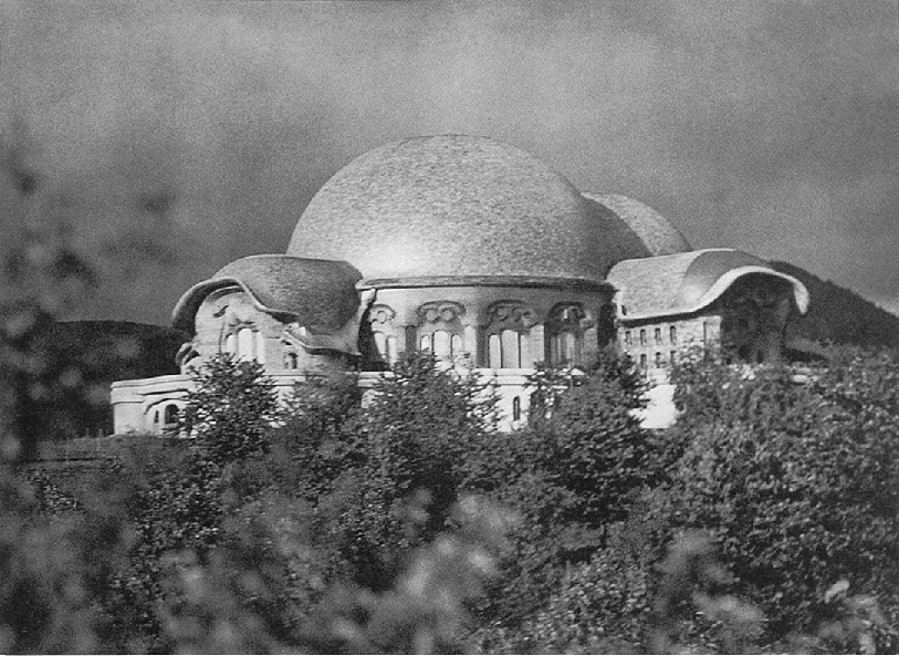
The Goetheanum, as a finished structure in all its beauty, was able to speak its message to humanity only for a few short years. The full wonder of it was revealed to but a small group of people, although day in and day out crowds of eager sight-seers wound up the hill, there to open their hearts to the breath of the Spirit, in curiosity, wonder, admiration, emotion, and — richer by yet another longing — once again to wend their way back to the world of banality. For a short span of time certain human souls had gazed at wonderland, had been raised above themselves, while others were seized by the forces of hatred and anger. Nobody was left indifferent. To those, however, who had learnt to understand the language of the forms, who had actually moulded them from the substance of wood with all its earthly solidity and at the same time ethereal flexibility — to those and to their companions in this work of regeneration, were revealed ever deeper, ever vaster world-connections under the mighty sweep of the architraves, between the capitals and plinths of the columns, whose motifs stood out with sudden boldness and novelty in the process of metamorphosis. There they wound, in and out each other, striving organically from primordial simplicity to complexity of form, and then back in a decrescendo to an inwardly deepened simplicity.
It was an architecture that developed onwards like a symphony, flowing into harmony — an architecture condensed into earthly substance from ethereal worlds, sending forth into space formative forces which were bound to take hold of the creative impulses of man and transmute them. The proportions of this architecture rendered it a dream in wood, too fair to endure, too pure not to be hated to its destruction, yet strong enough to call the new, of like nature with itself, into being.
Life, new and growing, is the Spirit's answer to the stab of death. Life, rich and abundant, is coming to flower around the urn where rest the ashes of Rudolf Steiner and round the new Building arising from the ashes of the old. The wide-flung sparks from the burning brand of the Dornach Sylvester night are becoming a spirit-seed, and those flames will be changed into spiritual life. However feeble our deeds may be, there lies, none the less, in the accomplished work of what has passed away, the Future that rescues mankind from a second death.
Therefore I have ventured to publish these lectures wherein Rudolf Steiner led us to the precincts where his spirit unfolded its creative Art, the while we worked with him in the newly built worksheds of the future Goetheanum. In the evenings we used to encamp ourselves among the planks in the great shed where the gigantic columns were put together, among the machines that shortly before had been ceaselessly working and now had come to momentary rest. There we listened to his words — words which opened up for us in all their inexhaustible fulness, new regions of his spirit, new depths of his being. We hardly dared realise that it was actually our destiny to be able to live among it all. And indeed, near Rudolf Steiner, there was no opportunity for self-indulgence. Time did not permit it nor did the ethereal intensity of his personality, which demanded, by dint of perpetual example, a ceaseless moving from one task to another. The soul had perforce to brace itself to receive the greatness and intensity of that mighty inrushing stream of the Spirit. And indeed if it had not been for the unending kindness and gentleness of one who was ever giving and creating, the soul, without having the power to assimilate all this wealth, could scarcely have endured the strain. Only if the soul were willing to accept this as a necessary sacrifice in the service of man, could it rise above the sheer intensity of the torrent — and then its power was borne as if on wings.
The work on the growing building demanded the constant presence of Rudolf Steiner, and so the earlier life of ceaseless journeys in the service of Spiritual Science was temporarily discontinued. With the erection of the building an abundance of new tasks fell upon him, tasks that he gratefully and willingly took upon himself, though only after repeated requests and urgings that were proof against all discouragement, from friends in Munich who had seen the Mystery Plays there and wanted to build a hall for them. When the building plans were rejected in Munich the pleadings continued, with the same insistence, that they should be carried through in Switzerland. This entailed many burdens for Rudolf Steiner, but his heart was full of gratitude and this gratitude and feeling of responsibility streamed with warmth and inwardness through all the words which stimulated us to work and to understand.
Listening to his words, which led us into new depths of being, we learned to know how in art man becomes one with divine creative power, if this, and not imitation, is the source of his own creative activity; we learned how the Divine-spiritual lives and moves within man as abundance of power if he becomes conscious of his connection with the universe. By giving form and mould to what lives in cosmic laws, by dint of inner penetration of spiritual connections, man creates art that is born from the depths of the universe and his own being. This is no mere hearkening to the secrets of nature; it is a fathoming of the hidden spirituality active behind nature. A fiery power thrilled through Rudolf Steiner's words and gave us life. We were able to feel how ancient civilisations had arisen out of these impelling forces of art and how in our spiritless age of disenchantment, degeneracy and barreness, the same possibilities are once again offered, at a higher stage, at the stage of conscious knowledge. A fire of enthusiasm thrilled through us and gave our artists strength to work, year in and year out, with chisel and mallet at the wood, with diamond drill at the glass of the windows, each of a single colour and shining only in different colours at their different positions in the Building. Both inside and outside, the Building stood there as a masterpiece of art created by a human hand; the relief-modelling of its inner surfaces might well be an organ for the speech of the Gods; its windows showed in the coloured shades of their designs the way to the Spirit, the stations along the path to the spiritual world. Those walls that became living through the movement in the forms, those light effects that were charmed into the windows by the thickness or thinness of the glass surfaces, called to the soul, now also stirred to action, to tread the path to regions whose speech flowed through the ethereal forms in the wood, through the windows which linked the outer and inner worlds together in a music of spiritual harmony.
All earlier buildings pointed to a connection with the earth, they rested within the earthly forces; here the walls were living, inducing exaltation and deepening alike, portraying an onward flowing evolution.
"Thus, O Man, thou findest the way to the Spirit!" — This was what spoke from the forms and windows of the Goetheanum. Gothic architecture contained the prayer: "O Father of the Universe, may we be united with Thee in Thy Spirit." The hidden Spirit permeating man makes him able to experience the world in forms and movements which to-day confront us like riddles. Rudolf Steiner expresses the thought of the new art of architecture in these words: "We enter with reverence into the Spirit, in order that we may become one with the Spirit which pours out around us in the forms and enters into movement — for behind the Spirits of Form stand the Spirits of Movement."
To-day, the inner, living growth of man's being would fain come to expression in a building art which in ancient Greece created the dwelling place of the God, and in Gothic times the house of the community in prayer.
The lectures in which Rudolf Steiner thus spoke to us of the new style of architecture, of the art of relief and of the nature of colour, are only available in imperfect, incomplete transcriptions. Sketches made at the time are in many cases missing, as well as quotations which after this long lapse of time can no longer be found when a name had by chance escaped the stenographer. Yet so great is the abundance of the revelations, both in a spiritual and artistic sense, that I feel it my duty to make them accessible to the world. The series of these lectures was broken by the World War, to which the sorrowful utterances of the last lecture point as if prophetically. One after another our artists were called away to the scene of war. With very few exceptions, there remained only those men who belonged to neutral countries, and the women. In the early days of the war, Rudolf Steiner gave us a First Aid Course. For four years we heard the cannons thundering in neighbouring Alsace and they were the terrible daily accompaniment to the beats of the hammer in a work of peace and human brotherhood. Rudolf Steiner's constant thought and heart-rending care during this time was the bringing to pass of peace, of an understanding for its necessity, but his warning voice was unheard. In spite of the deep sorrow into which the tragedy of world happenings plunged him, the words he spoke to those who were working at the Building were as full of light and as kindly as the doors he moulded, as the staircase that called out its welcome to those who entered, crying to them to be fully Man in the service of the radiant, sun-lit power of the Spirit.
In order to give an impression of these stairways, these doors and relief motifs, a series of photographs has been added to the lectures. The first shows the Goetheanum with its double domes in the blossoming time of the Jura countryside. This interpenetration of the two unequal sized domes called forth the astonished admiration of architects and engineers. It was a mathematical problem which they felt themselves wholly unable to solve. A well-known architect from California, who had constructed many great public buildings there, could not say enough in admiring appreciation: "The man who has solved this problem is a mathematical genius of the highest order. He is a master of mathematics, a master of our science: from him we architects have to learn. The man who built this has conquered the heights because he is master of the depths."
Here too, as in other spheres, experts recognised their master in Rudolf Steiner.
MARIE STEINER.
Dornach, April 1926.
7 June 1914, Dornach
A thought that may often arise in connection with this building is that of our responsibility to the sacrifices which friends have made for its sake. Those who know how great these sacrifices have been, will realise that the only fit response is a strong sense of responsibility, for the goal at which we must aim is the actual fulfilment of the hopes resting in this building. Anyone who has seen even a single detail — not to speak of the whole structure, for no conception of that is possible yet — will realise that this building represents many deviations from other architectural styles that have hitherto arisen in the evolution of humanity and have been justified in the jugdment of man. An undertaking like this can of course only be justified if the goal is in some measure attained. In comparison to what might be, we shall only be able to achieve a small, perhaps insignificant beginning. Yet, may be, this small beginning will reveal the lines along which a spiritual transformation of artistic style must come about in the wider future of humanity. We must realise that when the building is once there, all kind of objections will be made, especially by so-called 'experts,' that it is not convincing, perhaps even dilettante. This will not disconcert us, for it lies in the nature of things that 'expert' opinion is least of all right when anything claiming to be new is placed before the world. We shall not, however, be depressed by derogatory criticism that may be levelled at our idea of artistic creation, if we realise, as a compensation for our sense of responsibility, that in our age, the origin of the Arts and of their particular forms and motifs is greatly misunderstood by technical experts. And then, gradually, we shall understand that all we are striving to attain in this building stands much closer to primordial forces of artistic endeavour which are revealed when the eye of the Spirit is directed to the origin of the Arts, than do the conceptions of art claiming to be authoritative at the present time. There is now little understanding of what was once implied by the phrase "true artistic conception." It need not therefore astonish us if a building like ours, which strives to be in harmony with primordial Will and in accordance with the origin of the arts, is not well or kindly received by those who adhere to the direction and tendency of the present age.
In order to bring home these thoughts to you, I should like to start to-day by considering a well-known motif in art — that of the so-called acanthus leaf — showing the sense in which our aims are in harmony with the artistic endeavours of humanity as expressed in the origin of this acanthus leaf as a decorative motif. Now because our endeavours are separated by many hundreds, nay even thousands of years, from the first appearance of this acanthus motif, they must naturally take a very different form from anything that existed in the days when, for instance, the acanthus leaf was introduced into the Corinthian capital.
If I may be permitted a brief personal reference here, let me say that my own student days in Vienna were passed during the time when the buildings which have given that city its present stamp, were completed — the Parliament Buildings, the Town Hall, the Votivkirche and the Burgtheatre. The famous architects of these buildings were still living: Hanson who revived Greek architecture, Schmidt who elaborated Gothic styles with great originality, Ferstel who built the Votivkirche. It is perhaps not known to you that the Burgtheatre in Vienna was built according to the designs of an artist who in the seventies and eighties of the last century was the leading influence in artistic appreciation and development of form in architecture and sculpture. The Burgtheatre was built according to the designs of the great Architect, Gottfried Semper.
At the Grammar School I myself had as a teacher a gifted admirer and disciple of Gottfried Semper, in the person of Josef Baier, so that I was able to live, as it were, in the whole conception of the world of architectural, sculptural and decorative form as inaugurated by the great Semper.
Now, in spite
of all the genius that was at work, here was something that
well-nigh drove one to despair in the whole atmosphere of the
current conceptions of the historical development of art, on
the one side, and of the way to artistic creation on the
other. Gottfried Semper was undoubtedly a highly gifted
being, but in those days the usual conception of man and the
universe was an outcome of the materialistic interpretation
of Darwin, and the doctrine of evolution was also apparent in
the current ideas of art. Again and again this materialistic
element crept into the conceptions of art. It was, above all,
considered necessary to possess a knowledge of the technique
of weaving and interlacing. Architectural forms were derived
in the first place from the way in which substances were
woven together, or fences constructed so that the single
canes might interpenetrate and hold together. In short,
people were saturated with the principle that decoration and
ornamentation were forms of external technique. This subject
of course might be further elaborated, but I only want to
indicate the general tendency which was asserting itself at
that time — namely, the tendency to lead everything
artistic back to external technique. The standpoint had
really become one of ultilitarianism and the artistic element
was considered to be an outcome of the use to which things
were put. All treatises on the subject of art, and especially
on decoration, invariably made mention of the special
idiosyncrasies of the different technical experts. This of
course was a stream running parallel to the great flood of
materialistic conceptions that swept over the 19th century,
chief among them being the materialistic conception of art.
The extent to which materialism asserted itself in all
spheres of life during the second half of the 19th century
was enough to drive one to despair. Indeed I still remember
how many sleepless nights I had at that time over the
Corinthian capital. Now the main feature, the principal
decoration of the Corinthian capital — although in the
days of which I am speaking it was almost forbidden to speak
of such a thing as 'decoration' — is the
acanthus leaf. What could be more obvious than to infer
that the acanthus leaf, on the Corinthian capital was simply
the result of a naturalistic imitation of the leaf of the
common acanthus plant? Now anyone with true artistic feelings
finds it very difficult to conceive that a beginning was
somewhere made by man taking a leaf of a weed, an acanthus
leaf, working it out plastically and adding it to the
Corinthian column. Let us think for a moment of the form of
the acanthus leaf.
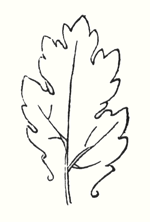
The basis of
all artistic creation is a consciousness that comes to a
standstill before the portals of the historical evolution of
humanity as depicted by external documents. A certain
consciousness that was once active in man, a remnant of the
old clairvoyance, belonged to the fourth Post-Atlantean
period, the Graeco-Roman. Although Egyptian culture belongs
to the third Post-Atlantean epoch, all that was expressed in
Egyptian art belongs to the fourth epoch. In the fourth epoch
this consciousness gave rise to such intense inner feeling in
men that they perceived how the movement, bearing and
gestures of the human being, nay even the human form itself,
develop outwards into the physical and etheric. You will
understand me if you realise that in those times, when there
was a true conception of artistic aim, the mere sight of a
flower or a tendril was of much less importance than the
feeling: 'I have to carry something heavy; I bend my
back and generate with my own form the forces which make me,
as a human being, able to bear the weight.' Men felt
within themselves what they must bring to expression in their
own postures. This was the sense in which they made movements
when it was a question of taking hold of something or of
carrying something in the hand. They were conscious of a
sense of carrying, of weight, where it was necessary to
spread the hands and finger outwards. Then there arose the
lines and forms which passed over into artistic creation. It
is as though one felt in humanity itself how man can indeed
go beyond what he sees with his eyes and perceives with his
other senses: — he can go beyond it when he enters into
and adapts himself to a larger whole. Even in this case of a
larger whole, when a man no longer merely lets himself go as
he walks along, but is obliged to adapt himself to the
carrying of a load — already here he enters into the
organism of the whole universe.
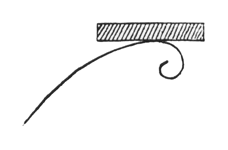
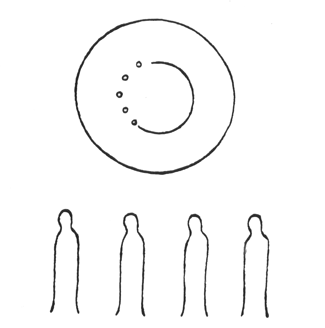
I have drawn it
diagrammatically, from the side view: a number of men are
walking one behind the other. They form the procession which
then passes round inside the circle; others are sitting in
the circle looking on.

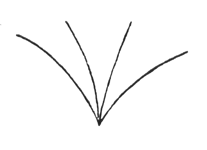
If you think of these two figures in alternation, you have the earth-motif and the sun-motif that were always carried by the people who formed the procession. This was one thing that in olden times was presented in circling procession. The people sat around in a circle and the actors passed around in a procession. Some of them carried emblems representing man's connection with the sun; and they alternated: earth-sun, sun-earth and so on:
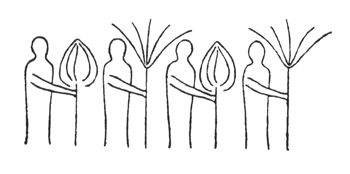
Man sensed this cosmic power: earth-sun, and then he began to think how he could portray it. The best medium for purposes of art proved to be a plant or tree whose forms runs upwards to a point from a wider base. This was alternated with palms. Plants having a form like a wide bud were alternated with palms. Palms represented' the sun forces; bud-forms running upwards to a point, the earth forces.
Feeling his place in the cosmos, man created certain forms, merely using the plants as a means of expression. He used plants instead of having to invent some other device. Artistic creation was the result of a living experience of cosmic connections; this is in accordance with the evolution of the creative urge in man and the process is no mere imitation of outer phenomena of nature. The artistic representation of the elements of outer nature only entered into art later on. When men no longer realised that palms were used to express the sun forces, they began to think that the ancients simply imitated the palm in their designs. This was never the case; the ancients used the leaves of palms because they were typifying the sun forces. Thus has all true artistic creation arisen, from a 'superabundance' of forces in the being of man — forces which cannot find expression in external life, which strive to do so through man's consciousness of his connection with the universe as a whole. Now all contemplation and thought both in the spheres of natural science and art, have been misled and confused by a certain idea which it will be very difficult to displace. It is the idea that complexity has arisen from simplicity. Now this is not the case. The construction of the human eye, for instance, is much more simple than that of many of the lower animals. The course of evolution is often from the complex to the simple; it often happens that the most intricate interlacing finally resolves itself into the straight line. In many instances, simplification is the later stage, and man will not acquire the true conception of evolution unless he realises this.
Now all that
was presented to the spectators in those ancient times, when
it was always a question of portraying living cosmic forces,
was later on simplified into the decoration, the lines of
which expressed man's living experience when he
presented these things.
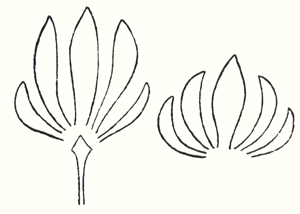
This alternation of Sun-motif, Earth-motif, presented itself to the artistic feeling of mankind as a decorative motif in the truest sense. Later on man no longer realised that he must see in this decorative motif a reproduction that had passed into the subconscious realm, of a very ancient dance motif, a ceremonial dance. This was preserved in the palmette motif. Now it is interesting to consider
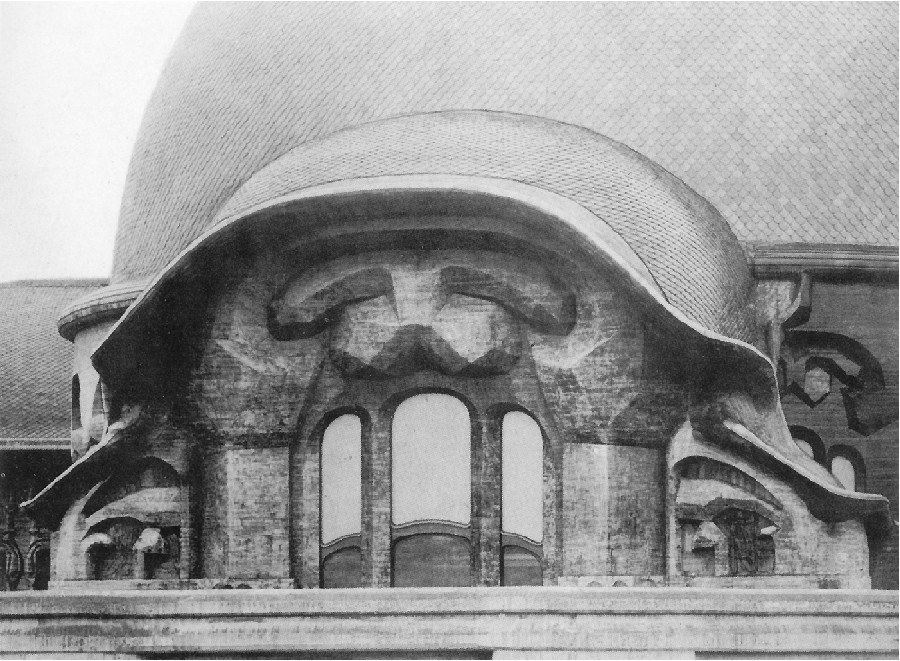
the following: — On the decorations of
certain Doric columns one often finds a very interesting motif
which I will sketch thus.
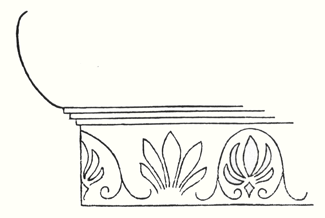
In Greece, that
wonderful land where the fourth Post-Atlantean period was
expressed in all its fulness, there was a union of what came
over from Asia with all that I have now described and which,
as an after-image is there, on Doric columns together with
the truly dynamic-architectonic principle of weight-bearing.
This union came about because it was in Greece that the Ego
was fully realised within the human body, and
therefore this motif could find expression in Greek culture.
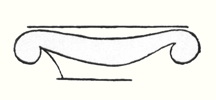
Now you need
only imagine what is merely indicated in the Ionic pillars,
the middle portion, developing downwards to the perfect
volute and you have the Corinthian column.
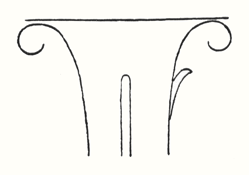
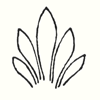
The essential forms of art can no more arise from an imitation of nature than music can be created by an imitation of nature. Even in the so-called imitative arts, the thing that is imitated is fundamentally secondary, an accessory as it were. Naturalism is absolutely contrary to true artistic feeling. If we find that people think our forms here are grotesque we shall be able to comfort ourselves with the knowledge that this kind of artistic conception sees in the acanthus motive nothing but a naturalistic imitation. The acanthus motif, as we have seen, was created purely from the spirit and only in its late development came to bear a remote resemblance to the acanthus leaf. Artistic understanding in future ages will simply be unable to understand this attitude of mind which in our time influences not only the art experts who are supposed to understand their subject, but all artistic creation as well. The materialistic attitude of mind in Darwinism also confronts us in artistic creation, in that there is a greater and greater tendency to make art into a mere imitation of nature. My discovery of these connections in regard to the acanthus leaf has really been a source of joy to me, for it proves circumstantially that the primordial forms of art have also sprung from the human soul and not from imitation of external phenomena.
I was only able really to penetrate to the essence of art after I had myself moulded the forms of our building here. When one moulds forms from out of the very well-springs of human evolution, one feels how artistic creation has arisen in mankind. It was a strange piece of karma that during the time when I was deeply occupied with following up a certain artistic intuition (this was after the forms for the buildings had already been made) — an intuition that had arisen during the General Congress in Berlin — it happened that I began to investigate what I had created in these forms, in order to get a deeper understanding. One can only think afterwards about artistic forms; if one "understands" them first and then carries them out, they will have no value. If one creates from concepts and ideas nothing of value will ensue, and the very thing that I perceived so clearly in connection with the acanthus leaf, and have shown to be erroneous, is an indication of the inner connections of the art in our building.
I came upon a remarkable example which is purely the result of clairvoyant investigation. At one point I discovered a curious point of contact with Rigl, a fellow-countryman of mine. It is a curious name, not very aristocratic, but typically Austrian. This man Rigl did not achieve anything of great importance but while he was Curator of an Architectural Museum in Vienna he had an intuitive perception of the fact that these architectural decorations had not arisen in the way described by "Semperism" at the end of the 19th century. Rigl hit upon certain thoughts which are really in line with the metamorphosis of the palmette motif into that of the acanthus leaf. Quite recently, therefore, I have discovered a perfect connection between the results of occult investigation, and external research which has also hit upon this development of the so-called acanthus motif from the palmette. 'Palmette' is of course merely a name; what is really there in the palmette is the Sun-motif. In the first place, of course, one feels in despair about an idea like that of Rigl. He simply could not realise whence the palmette motif had originated and that it was connected with forces working and moving in man. Rigl remonstrates with the learned art critics who have brought Semper's ideas into everything and are for the most part mere naturalists, but in spite of this he did not get very far. He says that in regard to the acanthus leaf the learned art critics are still feeding upon the old anecdote quoted by Vitruvius. (It cannot be said that they are all feeding upon it, but it is true that they constantly quote it.) Rigl, however, only mentions this anecdote briefly; he does not think it worth while to go into all the details because it is too well known. What he leaves out is very characteristic. He says that Callimachos had seen a basket surrounded by acanthus leaves and that then the idea of the Corinthian column came to him. Rigl, too, leaves something out and this very thing shows that the typical conceptions of our age must despair of ever having real knowledge in this sphere. He leaves out the most important factor in the whole anecdote, which is that what Callimachos saw was over the grave of a Corinthian girl. That is the important thing, for it implies no less than that Vitruvius, although he wisely holds his tongue about it, intends to indicate that Callimachos was clairvoyant and saw, over a girl's grave, the Sun-motif struggling with the Earth-motif, and above this the girl herself, hovering in her etheric body. Here indeed is a significant indication of how the motifs of Sun and Earth came to be used on the capitals of columns. If we are able to see clairvoyantly what is actually present in the etheric world above the grave of a girl who had died, we realise that the palmette motif has arisen out of this, growing, as it were, around the etheric body that is rising like the sun. It seems as though men have never really understood the later Roman statues of Pytri-Clitia for they are nothing else than a clairvoyant impression that can be received over the graves of certain people; in these statues, the head of an extraordinarily spiritual, though not virginal Roman woman, seems to grow upwards as if from a flower chalice. Some time, my dear friends, we shall understand what really underlies the anecdote quoted by Vitruvius, but not until we grow out of the unfortunate habit which makes us perpetually ask, 'What is the meaning of this or that?' and is always looking for symbolic interpretations such as, 'this signifies the physical body, that the etheric body, this or that the astral body.' When this habit is eliminated from our Movement we shall really come to understand what underlies artistic form — that is to say, we shall either have direct perception of true spiritual movement, or of the corresponding etheric phenomenon.
It is actually the case that in clairvoyant vision the acanthus leaf can be seen, in its true form, above a grave.
If you will
consider all these things; my dear friends, you will realise
how important it is to understand the forms in the interior
of our building, the forms that should adorn it, and to know
the artistic principle from which they have arisen. On
previous occasions I used a somewhat trivial comparison, but
it is only a question of understanding the analogy. Although
it is trivial, it does, nevertheless, convey what it is
intended to convey. When we are trying to understand what
will be placed in the interior of the building in these two
different sized spaces, we may with advantage think of the
principle of the mould in which German cakes are baked.
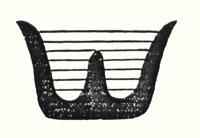
It would have been my wish — only it was not to be — that we should have had no such surfaces as these (pointing to an architrave). They will only be right — when something is taken away from them. This roundness here must be eliminated. It would have been better if from the very beginning we had worked with the graver's chisel for then there would have been no protuberance but only a surface. What we must do is to feel from the models how the interior decoration is the plastic vesture for the Spiritual Science that is given its in the building. Just as the interior decoration has the quality of being 'in-carved,' so the outer decoration will seem as though it is 'laid on.' The interior decoration must always have the character of being in-carved. One can feel this in the model, for the essential thing is a true inner feeling for form in space. It is this that leaves one unsatisfied even in such writings as those of a man like Hildebrandt. He has a certain idea of the workings of form but what he lacks is the inner feeling of form — the inner feeling that makes one live wholly within the form. He simply says that the eye should feel at home when it looks at form. In our building we must learn to experience the forms inwardly, so that, holding the chisel in a particular way, we learn to love the surface we are creating — the surface that is coming into being under the mallet. I, for my part, must admit that I always feel as if I could in some way caress such a surface. We must grow to love it, so that we live in it with inner feeling and not think of it as something that is merely there for the eye to look at.
Just recently someone told me after a lecture that a certain very clever man had accused us of straining after 'externalities,' as instanced by the fact that different kinds of wood have been used for the columns in the interior. This shows how little our work has been understood. Such a thing is considered to be a dreadful externality. This very intelligent man, you see, simply cannot realise that the columns must be of different woods. The real reason why he cannot understand, is that he has not paused to consider what answer he would have to make if he were asked: 'Why must there be different strings on a violin? Would it not be possible simply to stretch four A strings instead?' The use of different woods is a reality in just the same sense. We could no more use only one kind of wood than we could have only A strings on a violin. Real inner necessities are bound up with this. One can never do more than mention a few details in these matters. The whole conception of our building and what must be expressed in it, is based upon deep wisdom, but a wisdom that is at the same time very intimate. Of course there will be forms which are nowhere to be found in the outer physical world. If anything bears an apparent resemblance to a form in the animal or human body, this is simply due to the fact that higher Spirits who work in nature, create according to these forces; nature is expressing the same things as we are expressing in our building. It is not a question of an imitation of nature, but of the expression of what is there as pure etheric form. It is as though a man were to ask himself: 'What idea must I have of my own being when I look away from the outer sense-world, and try to find an environment that will express my inner being in forms?' I am sure that everyone will be struck by the plastic forms on the capitals and in the rest of the interior. Not a single one of these forms is without its own raison d'étre. Suppose anyone is carving the column just here (pointing to an architrave motif). At another place he will carve more lightly or deeper down into the wood. It would be nonsense to demand symmetry. There must be living progression, not symmetry. The columns and architraves in the interior are a necessary consequence of the two circular buildings with the two incomplete domes. And I cannot express this any more precisely than by saying that if the radius of the small dome were at all larger or smaller in proportion to the large dome, each of these forms would have to be quite different, just as the little finger of a dwarf is different from that of a giant. It was not only the differences in dimension, but the differences in the forms that called forth the overwhelming feeling of responsibility while we were erecting the building; down to the smallest detail it could not be other than it is. Each single part of a living organism has to exist within and in accordance with the whole living organism. It would be nonsense to say: I want to change the nose and put a different organ in the place where the nose now is.' It is a matter of actual fact that the big toe, and the small toe as well, would have to be different if the nose were different. Just as nobody in his senses would wish to re-model the nose, so it is impossible that the form here should be other than it is. If this form were different, the whole building would have to be different, for the whole is conceived in living, organic form. The advance we must make is this: all that was, in the early days of art, a kind of instinctive perception of a human posture transformed into artistic form must now enter with consciousness into the feeling life of man. In this way we shall have, in our interior decorations, etheric forms that are true and living, and we shall feel them to be the true expression of all that is to live in our building. It simply cannot be otherwise.
Now the other day I received two letters from a man who, ten years ago, it is true, did belong to the Anthroposophical Movement, but who since then has left it. He asked me if he could be allowed to make the windows, for he was so well qualified for the work. He was really very insistent. But when you see the windows you will understand that they could only be made by somebody who has followed our work right up to the present. Suppose I were to press my hand into a soft substance: the impress could only be that of my hand, it could not be the head of an ox for instance! It is Spiritual Science that must be impressed into the interior decoration; and Spiritual Science must let in the sunlight through the windows in a way that harmonises with its own nature. The whole building is really constructed — forgive this analogy — according to the principle of the cake mould, only of course instead of a rising cake, it is filled with Spiritual Science and all the sacred things that inspire us. This was always the case in art, and above all it was so in the days when men perceived in their dim, mystical life of feeling the alternation of the principles of earth and sun in the living dance and then portrayed the dance in the palmette motif. So it must be when it is a question of penetrating the outer sense- veil of natural and human existence and expressing in forms things that lie behind the realm of sense perception — if, that is to say, we are fortunate enough to be able to carry this building through. How inner progress is related to the symptoms of onward-flowing evolution — this is what will be expressed in the building, in the dimensional proportions, forms, designs and paintings.
I wanted to place these thoughts before you in order that you may not allow yourselves to be misled by modern conceptions of art, which have put all true understanding on one side. A good example of this is the belief that the Corinthian capital arose primarily from the sight of a little basket with acanthus leaves around it. The truth is that something springing from the very depths of human evolution has been expressed in the Corinthian capital. So also we shall feel that what surrounds us in our building is the expression of something living in the depths of human nature behind the experiences and events of the physical plane.
To-day I only wanted to speak of this particular detail in connection with our building and with a certain chapter in the history of art.
There may be opportunities during the coming weeks to speak to you of other things in connection with some of the motifs in the building. I shall seize every available opportunity to bring you nearer to what is indeed full of complexity, but yet absolutely natural and necessary, in a spiritual sense, for our building.
In our days it is not at all easy to speak about problems of art, for naturalism, the principle of imitation, really dominates the whole realm of art. So far as the artist himself is concerned, naturalism has arisen out of a very simple principle; so far as other people are concerned it seems to have arisen from something less simple. The artist, when he is learning must, of course, copy the productions of his master; he must imitate in order to learn. Man now imitates nature out of instinct — for he has made the principle of pupil into that of master and has then put the master on one side because he will brook no authority. This principle is very convenient for artists, for they do not want to get beyond an artistic reproduction of the models before them. The layman to-day understands the principle of naturalism as a matter of course. Where can he find anything to take hold of when he sees forms like those in our building? How are these forms to stimulate any thought at all? He will tear his hair and ask, with a shrug of his shoulders: 'Whatever is this?' And he will be lucky if he finds anything at all to take hold of, for instance, if he discovers that some detail has a slight resemblance, maybe to a nose! Although this may be negative, he is delighted that he has discovered anything at all. To-day the layman is pleased if when he finds in the different arts something that transcends the purely naturalistic element, he can say: 'This has a resemblance to something or other.' Art will most certainly be misunderstood if people continue to think that it is only legitimate to express things that resemble something or other in the external world. Real art does not 'resemble' anything at all; it is something in itself, sufficient unto itself. And again from this point of view it was despairing to find that as a result of the materialism of the second half of last century, painters (not to speak of sculptors) were asking themselves for instance: 'How am I to get the effect of that mist in the distance?' And then all kinds of attempts were made to reproduce nature by pure imitation. It really was enough to drive one to despair! Ingenious things were produced, it is true, but what is the value of them? It is all far better in nature herself. The artists were wasting their time in their efforts to imitate, for nature has it all in a much higher form. The answer to this problem is to be found in the Prologue to "The Portal of Initiation." [The first of Dr. Steiner's Mystery Plays.]
Not long ago we happened to be going through the Luxemburg Gallery in Paris, and we saw a statue there. At first sight it was exceedingly difficult to make out what it was supposed to be, but by degrees it dawned on one that perhaps it was meant to represent a human figure. It was so distorted .... I will not imitate the posture, for it would be too much of a strain on the shoulders and knees! It is an absolutely hideous production, but I assure you that if it were to meet one in nature it would be much easier to understand than this "work of art." People to-day do not realise the absurdity of giving plastic form to a motif that has been thought out, for there is, as a matter of fact, no real necessity to give it plastic form. That which is to be given plastic form must from the very beginning be there in itself and only conceived of plastically. No true sculptor will say that Rodin's productions are an expression of true plastic art. Rodin models non-plastic motifs very well, in an external sense, but true artistic feeling will always be prompted to ask if it amounts to anything, for true plastic conception is entirely lacking. All these things are connected, my dear friends. I have told you what happened in my young days, when I was about 24 or 25 years old, when I absorbed the doctrines of Semper. Already then they were enough to drive one to despair and their influence has not been got rid of yet. Therefore I ask you — and more particularly those who are working so devotedly and unselfishly at our building with all the sacrifices that their work entails — always to try to proceed from inner feeling for what this building ought to contain and to feel in life itself the forms which must arise, in order that we may free ourselves from the trammels of much so-called modern "art." We must realise, in a new sense, that art is born from the depths of man's being. So greatly is this prone to be misunderstood in our age that people have taken the metamorphosis of of the Earth and Sun motifs to be an imitation of the acanthus leaf. If people will stop believing the anecdote quoted by Vitruvius, that Callimachos saw a basket strewn around with acanthus leaves and then used it as a motif on columns, and will listen to what he says about Callimachos having had a vision over the grave of a Corinthian girl, they will also realise that he had clairvoyant sight and they will have a better understanding of the evolution of art. They will realise that development of clairvoyance leads man to the realm lying behind the world of sense. Art is the divine child of clairvoyant vision — although it only lives as unconscious feeling in the soul. The forms that are seen by the clairvoyant eye in the higher worlds cast their shadow pictures, as it were, down to the physical plane.
When people understand all that lives in the Spirit — the Spirit which has the power to impress itself into what surrounds us here in our building, finding its expression in the outer framework around us —they will also understand the goal we have set ourselves, and see in the forms of art the impress of what has to be accomplished and proclaimed in living words in our building. It is a living word this building of ours!
Now that I have tried, scantily, it is true, to indicate something in regard to the interior we shall, before very long, be able to speak of the painting and also of the outside of the building.
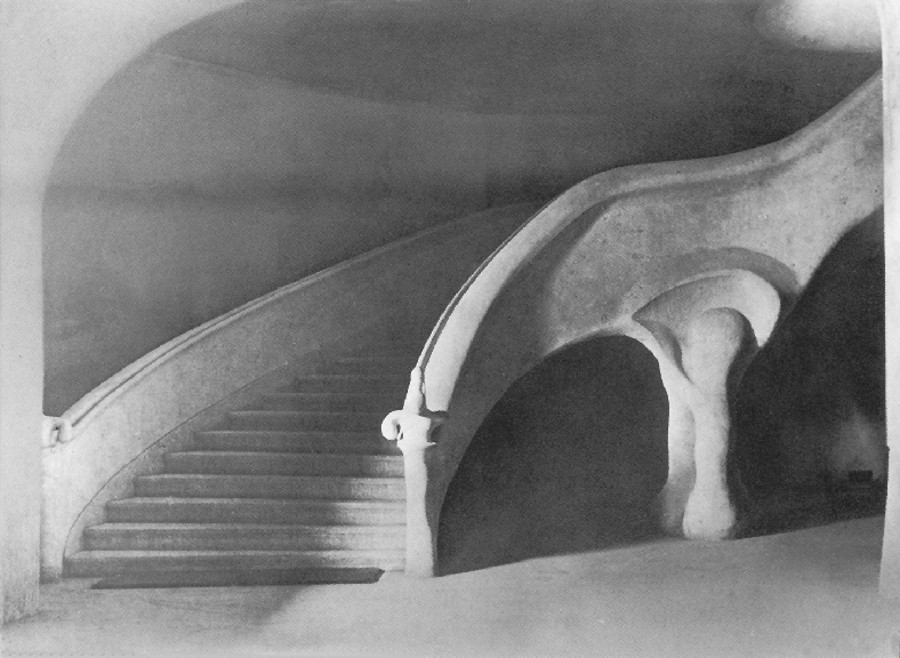
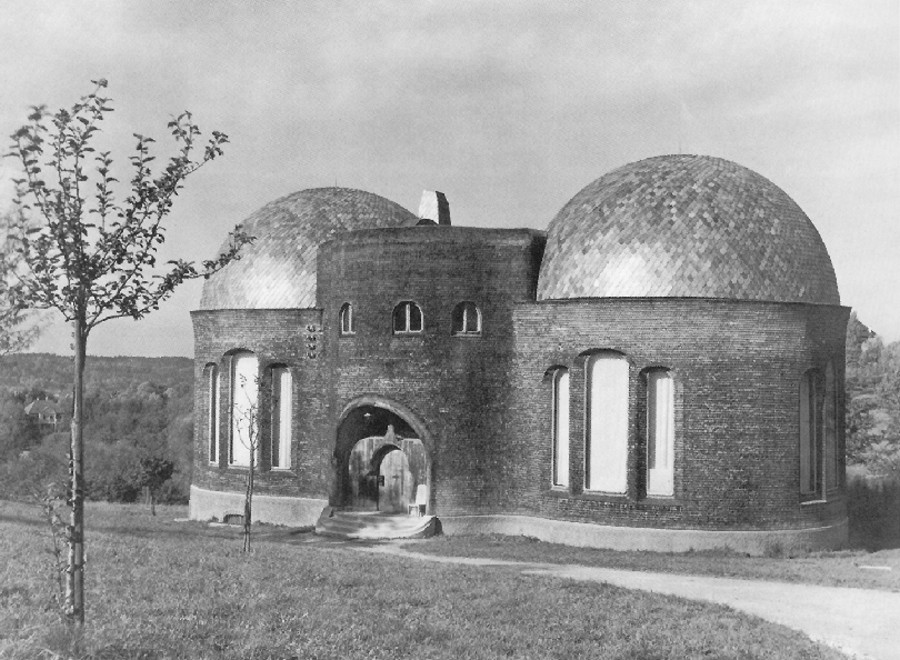
17 June 1914, Dornach
Even more than on the last occasion when I spoke to you about our building am I reminded to-day of the attitude we must have to this edifice, dedicated as it is to the cause of Spiritual Science. The sacrifices of those who have befriended the cause of Anthroposophy call for a sense of great responsibility. To-day is a splendid occasion for reminding ourselves of this responsibility, for the first of our auxiliary buildings is to be given over to its own tasks. We can be reminded of this responsibility by studies that arise naturally out of the tasks before us and the goal we are striving to attain.
The immediate use to which these rooms will be put is the production of the glass windows for our building, and we cannot help being moved by the thought that our human faculties are not really mature enough as yet to accomplish the full task before us. I think it is healthy and good that all our work should be permeated by the feeling that we have not as yet grown equal to our task, for only this can enable us to accomplish the highest that lies within our power. We shall be able to create the first beginnings of an artistic vesture for Spiritual Science — to the extent to which our epoch and our means allow — if we are always pervaded by the feeling that we are, in truth, little qualified for the full task. The site on which our building stands is pervaded by an atmosphere which seems to say: "Do the very utmost of which your powers and faculties are capable, for you cannot do nearly enough in comparison with what ought to be achieved; and even when you have done your very utmost, it will not by any means suffice."
When we look at the site of our building we should be pervaded by an indefinable feeling — a presentiment that a mighty task is hovering before us. And more particularly should this be the case to-day when we are handing over this auxiliary building to our friend Rychter and his workers, in order that they may create something that in the fairest sense may be a living member in the whole organism of our building.
Entering the room through this door, our feeling will be that we are indeed blessed, as individuals, in having the opportunity to co-operate in work like this. And when we think of the functions of the windows in the building, an atmosphere of the soul and spirit will hover around us, whispering of the deep spirituality which we pray may flow like purifying waves of healing through this room.
When the building is once ready we shall again and again be conscious of a feeling which I may perhaps express as follows: 'How infinitely necessary it is to grow beyond everything personal, if the forms of this framework for our Spiritual Science are to have real meaning for us.' This again is, in a certain sense, the satisfying element in our building. Our architects, engineers, and all the other workers may well derive strength from the comforting feeling that apart from all the cares and troubles which the building involves, it can itself be for us a wonderful education — an education leading us above everything personal. The building demands a great deal more than the expression of any personal element. As we set about our work, and permeate the single forms with thought and feeling, we become conscious of new tasks of which we previously had no inkling. We feel that a mystery is there around us, calling out to the highest forces of soul, heart and mind to create something that transcends personality. This building can teach us how to fulfil the tasks which arise every day. It brings home to us a feeling that can ring in such sacred tones in the soul: How infinitely greater are the potentialities of the Universe than insignificant human beings! The highest we can create must be infinitely greater if it is to prove equal to the tasks before us in the objective world.' All that can ever be enclosed within the limits of the personal self must be transcended. The building itself, and the auxiliary house we have been able to open to-day can be a means of education for us. Indeed, the more they become a means of education, the greater understanding we shall have. Already now, as we look at the incomplete building and at this house, we cannot help thinking of what our feeling should be as we enter. How often we shall feel, 'Ah, if only all human beings could be led here!' Do we really deserve so sacred a framework — a framework we ourselves have helped to create — if we have any desire to exclude other human beings? Shall it not rather be our dearest wish to bring all men into the building? This will certainly be our desire if we realise the mission that such buildings will have to humanity, if they find imitators and followers?
Think for a moment of many buildings erected in our times by clever architects. Some of them, although they show no signs of a new style and are not permeated with any new spirituality, are really creations of architectural genius. Yet they all have one thing in common. We may admire them from outside and think them beautiful inside, but they do not make us feel, as our building will do, that we are enclosed as if by organs of sense. The reason for this is that these other buildings are dumb — they do not speak. This is the thought that I would like to press home to you this evening.
Let us think of buildings which express all the characteristics of our times. People pass in and out without in any way growing into their architecture, forms or art. Everywhere we feel that what ought to be expressed through the forms of art has to-day to be communicated to humanity by other means. In the present age man is more and more compelled to bring about order, stability, peace and harmony by means of external laws, decrees or institutions, definitions in words. This implies no syllable or thought of criticism, for it must be so in our age. But something must be added to this — something that signifies the onward evolution of humanity in a different sense. It is probable that our building will not be able fully to attain its goal — indeed we are only aiming at a primitive beginning. Yet if human culture is able to take what is expressed in our building (in so far as we fulfil the tasks set us by the higher Spirits) and develop it; if the ideas underlying such works of art find followers — then people who allow themselves to be impressed by these works of art and who have learnt to understand their language, will never do wrong to their fellow men either in heart or intellect, because the forms of art will teach them how to love; they will learn to live in harmony and peace with their fellow beings. Peace and harmony will pour into all hearts through these forms; such buildings will be 'Lawgivers' and their forms will be able to achieve what external institutions can never achieve.
However much study may be given to the elimination of crime and wrong-doing from the world, true redemption, the turning of evil into good, will in future depend upon whether true art is able to pour a spiritual fluid into the hearts and souls of men. When men's hearts and souls are surrounded by the achievements of true architecture, sculpture and the like, they will cease to lie if it happens they are untruthfully inclined; they will cease to disturb the peace of their fellow men if this is their tendency. Edifices and buildings will begin to speak, and in a language of which people to-day have no sort of inkling.
Human beings are wont to gather together in Congresses to-day for the purpose of putting their affairs in order, for they imagine that what passes from mouth to ear can create peace and harmony. But peace and harmony, and man's rightful position can only be established when the Gods speak to us. When will the Gods speak to us?
Now when does a human being speak to us? — When he possesses a larynx. He would never be able to speak to us if he had no larynx. The spirits of nature have given us the larynx and we make this gift an organic part of the whole cosmos when we find the true forms of art, for they become instruments through which the Gods speak to us. We must, however, first learn how to make ourselves part of the great cosmos, and then our desire to lead all mankind through these doors will be the stronger. Out of this desire — for its fulfilment is not yet — the longing will develop to work so intensely for our spiritual movement that this aim may gradually be attained. Art is the creation of an organ through which the Gods are able to speak to mankind .... I have already spoken of many things in this connection. I have spoken of the Greek Temple and have shown how all its forms express the fact it is a dwelling place of the God. To-day I want to add something to this. If we try to understand the basic nature of the Greek art of building we shall realise that the very being and essence of the fourth Post-Atlantean epoch flowed into the Greeks' mode of perception and thence into their art of building.
What is the basis of Greek perception and feeling? It is, of course, a wide subject, but I will only speak of one aspect.
Here (see diagram) we have the wall surrounding the Greek Temple, with the horizontal structure resting upon it. When anything rises above the horizontal it is so constructed that it is upheld by its own forces which balance each other; just as when, in building, we place two beams together.
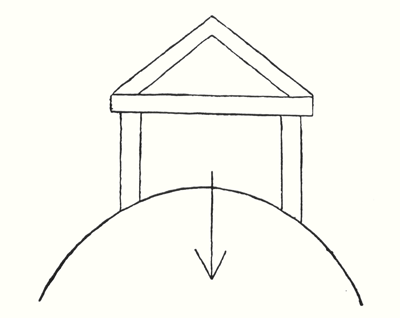
The presupposition here is that the earth with its gravity lies beneath. And translating this feeling into words, we may say: 'In the fourth Post-Atlantean epoch man felt that the site of the earth was a gift of the God; it was as though Divine power overflowed into the creations of art.' Therefore, by means of the forces in the earth given to man by the Gods, it was felt that gravity could be overcome. In the Greek Temple man controls the force of gravity and thereby creates a dwelling place for the God who has given him the earth.
Neither this "dwelling-place of the God" nor the later Roman Temples can be thought of apart from the surrounding land. The land is part of the Temple itself. A Greek Temple is complete in itself even if nobody is within it, for its whole conception is that of the dwelling-place of the God; it is the sanctuary of the God. Human beings may live for miles around in the district; if nobody enters the Temple, it stands there, none the less, complete in itself — a dwelling-place of the God. In every detail we see how man expresses in the decorative forms of these dwelling- places of the Gods all that his feeling of veneration makes him feel he ought to do for the Gods. In the last lecture I tried to show you that the motif on the capitals has its origin in a dance motif — a dance that was performed as homage to the Gods of nature. And now let us pass on to the forms of the earliest Christian architecture. One thought in particular arises within us when we pass from the Greek Temple to the Church of Christendom. The Greek Temple stands within its surrounding territory, belongs to the territory. Human beings are not necessarily within the Temple; they live around it, outside it. The Temple belongs to the surrounding territory, is thought of as the altar of the land around it. The Temple hallows everything, even the trivial daily occupations of the human beings who live on the land. Service rendered to the earth becomes a divine office because the God stands or is enthroned as Lord and participates in the work on the land and in the pursuits of human beings living around the Temple. Man feels himself united with the God as he works on the land. Worship of the God is not yet separated from service to the earth. The Temple grows out of the human element, sometimes indeed out of the 'all-too-human,' and hallows everything around it. 'Earth, be thou strong!' — This is the prevailing mood of the fourth Post-Atlatean epoch, when human beings are still at one with the earth which the Gods have given into their charge, when the Ego is still slumbering in a kind of dream consciousness, when man still feels himself connected with the Group-Soul of the whole of humanity. Then man grows out of this Group-Soul, becomes more and more individual, and he separates from the land, from daily life and activity, the worship he performs in his spiritual life.
In the early days of Christianity the feelings of men were no longer the same as in the Greek age. Looking into the soul of the Greek, we see him sowing his fields and working at his industrial pursuits, pervaded by this unshakable feeling: There stands the Temple with the in-dwelling God and I am near. I may be carrying out my pursuits and working on the land but all the while the God is dwelling there within the Temple. Then man grows more individual, a strong sense of Ego, of "I" arises within him, and Christendom represents the emergence of something that had been prepared through the course of long ages by the ancient Hebrew civilisation. Out of the human soul arises the need to separate off from the affairs of everyday life the worship that is offered to the God. The building is separated from the land and the Church of Christendom comes into being. The land becomes independent; the building becomes an entity independent of the territory; it is an 'individuality' complete in itself. The Greek Temple was still a kind of altar for the whole territory, whereas the walls of the Christian Church now form a space set apart for those who are to worship. The forms of the Churches of Christendom and also of Roman architecture gradually come to express this individual, spiritual need of man, and they can only be understood in this sense. The place of the Greek within earthly existence was such that he said to himself: 'I can remain here with my flocks, carrying out my occupations, doing my work on the land, for the Temple stands there like an altar for the whole countryside: the God is dwelling within it.' In Christendom, man says: 'I must leave my work and repair to this building, for there I must seek for the Spirit.' The service of earth and the service of heaven are separated and the Christian Church more and more assumes a form where Greek and Roman architecture would no longer be suitable. It is a form which reveals that the community belongs to the church; the church is intended to enclose the community. Then, once again set apart from the community, we find the house of the priests, of those who teach. An image of the universe comes into being; the Spirit speaks to those who seek for the spirit, in precincts where they are enclosed within walls. The whole world was felt by the Greeks and Romans in former times in the same way in which the Christians afterwards felt the precincts of the Church with its enclosing walls.
And what the Greek Temple itself had been now became the chancel. Men sought now for a distinct image of the world whereas formerly they had taken the world itself and only placed within it, visible to outer senses, the Temple as the dwelling-place of God. Gothic architecture is really only a branch of what was already being prepared. The essential feature of Gothic architecture is that the weight is taken away from the walls and placed upon the pillars. What is the origin of this whole mode of construction, where the weight rests on pillars, which are so moulded that they are able to bear it? It is based on a quite different conception from that of the Greek Temple. When we pass to the pillars of Gothic architecture which take away the weight from the walls, we are no longer concerned with the pure force of gravity. Here, man himself is working. In the Greek Temple it is as though he frees himself from the earth's gravity and having gained knowledge of it within the earthly realm, now rises above it. In that man makes use of the force of gravity, he overcomes it. In the weight-bearing Gothic pillars we are no longer concerned with the pure working of the force of gravity; in the Gothic building the art of handicraft is necessary, of higher and lower handicraft. The need for the creation of precincts which enclose the community also gives rise, in Gothic architecture, to the need for something wherein the activity of the community plays a part. In the single forms we see a continuation, as it were, of what the people have learnt. The art of the hand-workers flows into the forms, and in studying these forms we see the art of human beings who have contributed their share, who have worked together. The old Roman Churches are still edifices which enclose the God. The Gothic Church is an edifice built by the community to enclose the God but one where the people have contributed their own handicraft. They do not only enter the Churches but they themselves work at the building as a community. In Gothic architecture this labour of human beings unites itself with the Divine. The souls of men no longer receive the Divine as a matter of course; they do not only come together and listen to the word of the Spirit proceeding from the chancel, but they gather around the God in their labours. Gothic Churches are really crystallised handicraft.
We can quickly pass over what came next, for it really amounted to a revival of classic architecture. In this connection it is not necessary to speak of the Renaissance; we will speak of what the fifth Post-Atlantean epoch demands of us.
Let us consider the element of weight and support, following it to the point where it becomes crystallised handicraft in Gothic architecture.
If we penetrate this with artistic feeling we realise that here is something at rest within itself, at rest within the earthly forces. All the forces of these edifices rest within the earthly element. The Greek Temple everywhere indicates the force of gravity and its own union with the earth. In the Greek Temple we can everywhere observe some manifestation of the force of gravity. Its very forms reveal a union with the earth.
And now let us
compare the basic form in our building that will confront
everyone even from the outside. I will make a rough diagram
of it. What is the characteristic of this motif?

I should have
to speak for a long time if I wanted to show that this is how
the art of relief first assumes its real meaning, but I will
only give you an indication of what I really have in mind. A
certain eminent artist of modern times has spoken a great
deal about the art of relief and has said some clever things.
He tells us to think of two panes of glass standing parallel
to each other and between them an intersected figure. We
should then be looking in the direction of the arrow
through the panes of glass at the figure ...
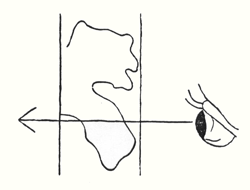
Now there is in the world a relief which is full of meaning, only we pay no proper attention to it. There is a certain relief that has been created in accordance with the true idea — it is the earth with her plant kingdom. We must, however, pass away from the surface of the earth into cosmic space before we can study this relief. The earth is the living surface which brings forth its creatures from its own being. Our own art of relief must be based upon the conception that the wall is a living thing even as the earth brings forth her plants. This is how a true art of relief is attained. To go beyond this principle is to sin against the essence of the art of relief. When we look down upon the great relief of the earth, we see human beings and animals moving upon it, but they do not belong to the relief. They can be introduced into the relief, of course, because the arts can be developed in all directions, but this is no longer the pure essence of the art of relief.
Our building
must speak through the forms in its interior, but the speech
must be that of the Gods. Think for a moment of the life of
human beings on the earth, that is to say, immediately on the
surface of the earth. Here we need not draw directly on our
teachings — we need only turn to the Paradise Legend.
If man had remained in Paradise he would have looked upon the
wonderful relief of the earth with her plant kingdom from
outside. He himself, however, was transplanted, as it were,
into this relief. He could not observe it from outside for he
was taken out of Paradise. The speech of the Gods cannot
ascend from the earth to men for the speech of the earth
drowns the speech of the Gods.
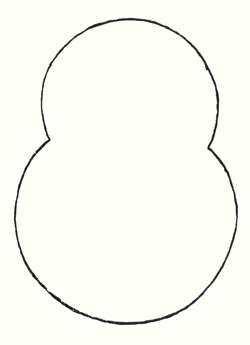
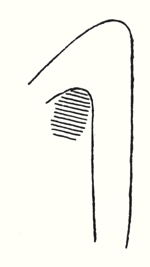
Nothing in this architecture is there for its own sake alone. The one form leads over into the other; or, if the forms have a threefold character, the central form is the bridge between the other two. Here we have a rough sketch of the forms of the doors and windows.
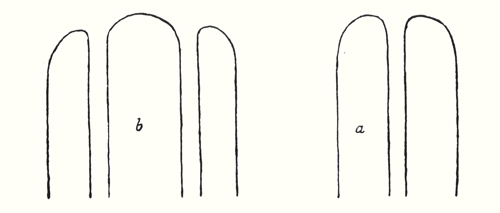
Now all that lives in the sculptured forms is three dimensional; relief is a conquest of the second dimension, surface, which is then brought into the third dimension. This is not realised if we merely take the standpoint of an observer or spectator: for we need a living feeling of how the earth allows the plants to grow out of her being.
When I come to speak of the real nature of painting we shall understand the significance of the connection between colour and the inner element of soul in the universe. There would be no sense in painting with colours if colour were not something quite different from what physics imagines it to be. The principles of colour as the speech of the soul of nature, of the soul of the universe, will be the subject of a later lecture.
I will now indicate how our glass windows are to represent the union of the outer with the inner. They will each in themselves be of one single colour, but different colours will be used at the various positions in the building. This expresses the spiritual, musical harmony of the outer with the inner world. And the single coloured window will only express this harmony in the thicker and thinner strata of the glass. That is to say, we shall have surfaces where the glass is thicker, more solid, and surfaces where the glass is thinner. The light will shine more strongly through the thinner places in the windows; it will shine less strongly, and produce darker colours, through the places where the glass is thicker. The connection between spirit and matter will be expressed in the glass windows; but the whole interior will strive to be an organ for the speech of the Gods. The larynx makes it possible for man to speak, and in the same way the whole of our relief-moulding is an organ for the Gods who should speak to us from all sides of the universe. So that when we make an aperture for the windows in the walls which allow the Gods to speak to us, we are seeking the path to the Spirits of the cosmos. These windows are intended to signify in their coloured shadings: 'Thus, O man, thou findest the path to the Spirit.' We shall see how the soul is connected with the spiritual world when it sleeps during the night and is living outside the body. We shall see the way in which the soul is connected with the spiritual world between death and a new birth in the disembodied state. The windows will show us how, when man approaches the threshold, he becomes aware of the abyss; the stations on the path to the spiritual world will be revealed. They will arise as light formations from the West, revealing to us the mysteries of Initiation. We are trying to create walls, the forms of which make the wall themselves seem to pass away. The designs must express how we pierce the walls, showing us how we find the path to the spiritual worlds, or traverse these worlds unconsciously, showing us what our relation to the spiritual worlds must be.
The Greek Temple, the dwelling place of the God, and the later edifice, which was built for the community desiring to be united with their God, were building-sheaths which enclosed and shut off. Our building must not shut off anything in the universe; its walls must live, but live in accordance with truth itself. Truth flows into the beauty of our relief-moulding. If we had not been driven out of Paradise we should be conscious of the ' speaking ' relief proceeding from the earth herself in the plant forms, which grow even above the geological formations of the mountains and only allow these strata to be bare in places where it is right that they should be bare. The moment however when we find in our perceptual life the transition from the 'repose' where the Gods speak to us, from that 'repose' to our own activity, to what we must do in order to find the way to the Gods — in that moment we must have movement, inner movement; we must pierce the wall. We must have these windows which call to our souls to tread the path to those regions whence the words expressed by the forms of the walls have proceeded. Then each one of us will sit within the building and we shall say to ourselves: "The organs of the great Spirits themselves are round about us; it is for us to understand the language spoken though these forms." But we must understand it in the heart and not merely be able to grasp it intellectually.
Those who begin to, explain' the meaning of these forms are on the wrong track. They stand on the same ground as those who interpret the old myths symbolically and allegorically, and imagine for instance, that they are advancing the cause of Theosophy. A man who tries to 'interpret' the myths and explain external forms may be clever and ingenious but he is like one who tries to look under his chin to explain the symbolism of his larynx. We understand the speech of the Gods by learning how to listen with our hearts, not by using intellectual agility and giving symbolic or allegorical meanings to myths and artistic forms. 'Here you sit and the Spirits of the Universe are speaking to you' — this must become a living feeling within us. When this becomes a living perception of what the soul must do if it is to find the way to those regions whence the speech of the Spirits proceeds, we shall direct our gaze to where the walls are pierced by the windows; and at those places there will be revealed to us the mysteries enacted in man as he consciously or unconsciously treads the path from the physical to the spiritual.
I have tried to express the feelings of our hearts and souls to-day when this house is being given over to the charge of our friend Rychter and his colleagues for their work. May they feel, as they receive it, the sacred nature of their task and something of the holiness of which I have spoken. Up on the hill itself we are still working at the building which will reveal, to those who seek, organs through which the Gods may speak to them. But there must arise in these seekers a holy longing to find the ways and paths to the realms of the Gods. The work of Rychter and his colleagues in the rooms of this house will be taken up the hill and placed in the positions where the walls are pierced. It will move the souls of those gathered together in the building at the top of the hill and show them the path to the Spirit.
May this holy mood pervade this house; may each drilling in the glass be carried out with the feeling: 'Here I have to mould something that will lead to the realms of the Spirits those who see it up there in the building. My creations must make the soul's perception so living that the shadings in the coloured glass will represent the channels by which the spiritual worlds are speaking through the forms in the interior.' The difficulties may be very great, indeed there may be only partial success in many cases and in other cases total failure, but the attitude I have described will be an unfailing help.
I did not intend to-night merely to speak of matters which may help to make art more intelligible. I have spoken as I have because I pray that something of what I feel may flow from my heart to yours. I want your hearts to be livingly permeated with a feeling inwardly vibrant with the sense of the holiness of this work. We dedicate this house of labour most fitly if as we leave the doors we concentrate with all the forces of our hearts on love for the world of man and of spirit, to the end that the way to the Spirit may be found through what is accomplished here — to the Spirit whence peace and harmony can flow among men on the earth. If all our labours are made living by the Spirit, if all the work on this hill is filled with the Spirit of Love — which is at the same time the Spirit of true art — then from our building there will flow out over the earth the spirit of Peace, of Harmony, of Love. The possibility will be created for the work on this hill to find successors; many such centres of earthly and spiritual peace, harmony and love may thus spring up in the world. Let us realise the living nature of our work in this mood of peace and loving harmony, knowing that our labours flow from the Spirit of Life itself. There have been dwelling-places of the Gods, sanctuaries of the community, and there yet will be an organ of speech for the Spirit, a building which points out the way to the Spirit. The God dwelt in the Greek Temple; the spirit of the community may dwell within the Roman or Gothic edifice; but the world of the Spirit itself must speak through the building of the future. We have seen the house of earthly forces and forms arise and pass away in the course of human evolution; we have seen the house of the union of human souls arise and pass away in the spiritual evolution of the earth. It is for us to build the house of speech out of our love for true art, which is at the same time love for true spirituality and for all mankind.
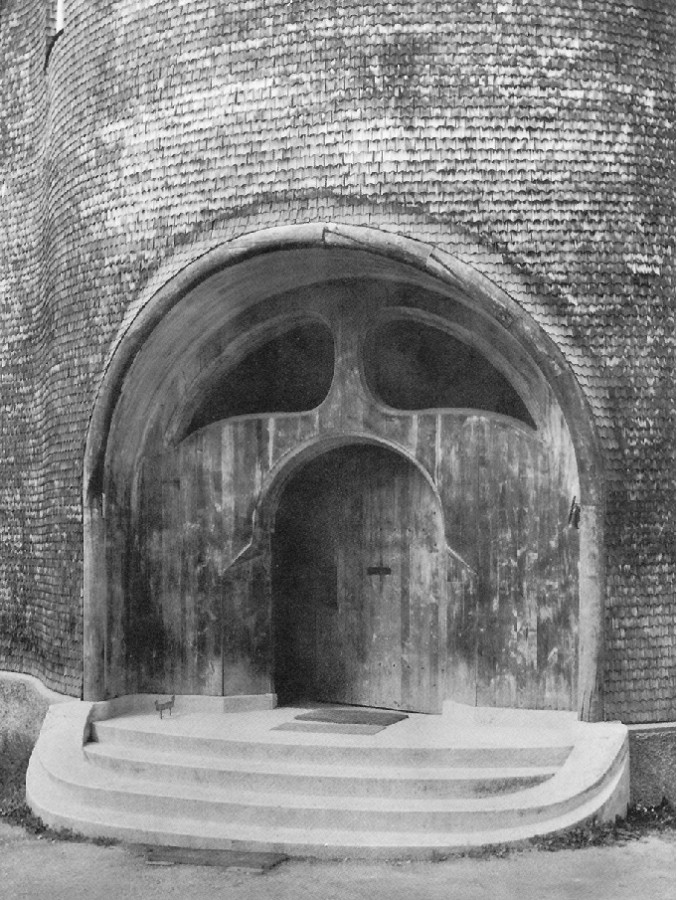
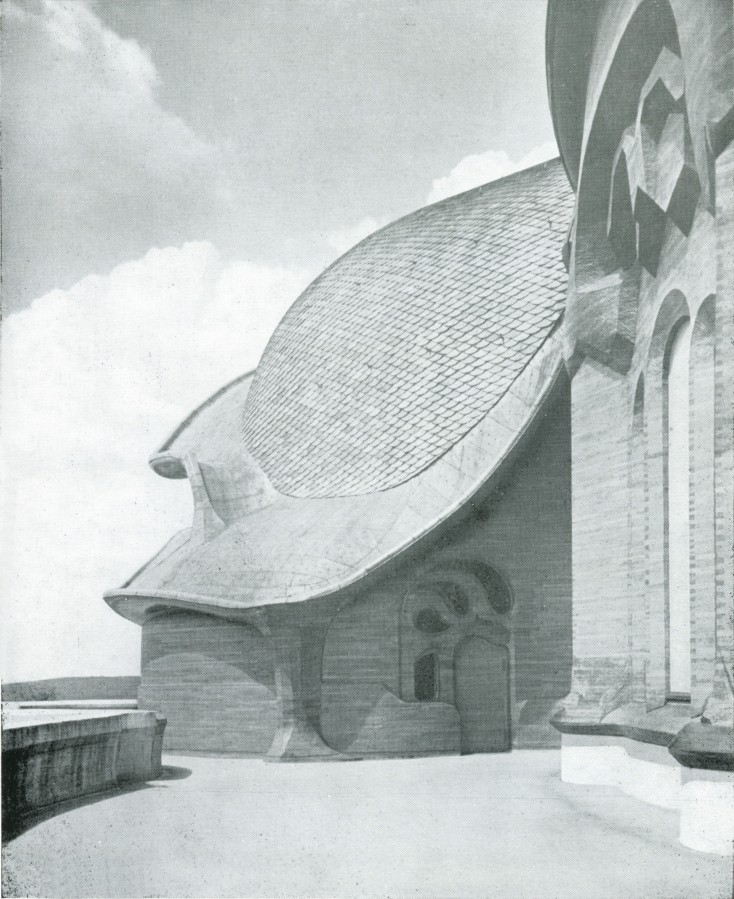
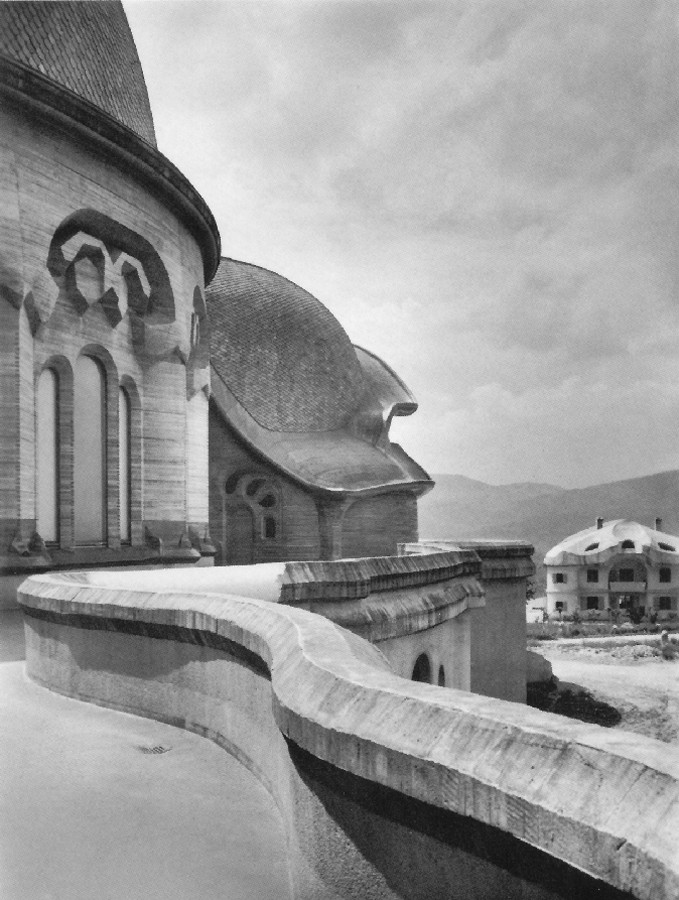
28 June 1914, Dornach
During the time when the construction of our building is proceeding I think it is a very good thing for us to try to grow more and more into its meaning. We have already made a beginning with the two previous lectures and we will try as far as we can, by means of further study, really to become one with what is to be accomplished here.
In the first place I should like to remind you of what I said when we opened the house dedicated to the work of constructing the glass windows. The lecture referred to the evolution of thought and conception underlying the art of building and I will just briefly recapitulate what I was then only able to indicate.
In regard to the Greek Temple, I said that in a certain sense it formed a unity with the whole countryside — the whole countryside was one with it. The Temple stood there as the 'dwelling place of the God.' Nothing need be in the Greek Temple save the spiritual presence of the God and his physical image. The essence of the construction of the Temple was the fact that every man engaged in his daily pursuits on the land knew that within the region where he was carrying on his work he was not merely alone with the earth but united with the spiritual world. And the token for the fact that man, as he lived on the earth, was also united with the spiritual world, was the Temple standing there like an altar in the land.
We then saw evidence of progress in architectural thought, in that the Christian art of building separated off the edifice from the land. Everyday life and the mood of exaltation by which man raised himself to the Spirit were separated from each other. The Church of Christendom is no longer actually one with the land; it serves the Spirit, apart from the countryside, and expresses the fact that when man is to rise to the Spirit he must leave the affairs of daily life, repair for a time to a place set apart and there be united with the spirit. The Church of Christendom, therefore, could no longer be what the buildings of Greece and also of Rome were in their real being. The Church of Christendom was in itself a duality, the house of the community and the house set apart for the altar and the priesthood. Man leaves the affairs of everyday life and enters into the precincts where he feels himself gazing upwards to the Spirit which comes to him from the chancel where the altar stands.
This evolution in architectural thought naturally implies the transformation of the ancient Greek form of building (which was derived purely from static and dynamic factors, the factors of space and gravity) into the form corresponding to the conception of the community being set apart.
Passing to the Gothic Cathedral we have a still later form of architectural conception. We have the striving of the community not only to bear their own personalities into the sanctuary but also their individual work, and this is expressed in the forms of Gothic architecture. We feel as if the work performed in the environment has passed into the architectural forms and rises to the Spirit like a prayer, a folding of the hands.
I also said that a real advance in architectural conception must come to pass again in our times and that this is only possible if the nearness to the Spirit which was achieved to an ever-increasing extent from the period of the Greek conception of architecture onwards to that of Gothic building — if this nearness is gradually transformed into a complete union with the Spirit. This means that buildings which should now be dedicated to life in union with the Spirit must in their very form express inner correspondence with the Spiritual. We can indeed say — if we try not to explain the thing in abstractions but to grasp it with the whole of our feeling and soul — 'All that is embodied in our life of soul through Spiritual Science implies an actual penetration into the form that is created. The Spirit is revealed in freedom, having now descended to mankind.' Whereas the Greek placed the Temple like an altar in the land, the future and, inasmuch as we are working from out of the future in our building, the present, are placing a true expression of the Spirit in the land as the result of what the Spirit expresses in its forms.
A speech which has a message for man of the present day will arise. But all this requires that we endeavour to understand the Spirit in its forms of expression. In order to understand the Greek Temple, we tried, last time, to grasp the purely physical qualities of space and of gravity. But the Spirit does not only work according to the laws of mechanics and dynamics; it does not only reveal itself in conditions of space and energy. The Spirit is living, hence it must be expressed in our building in a living way, a truly living way. We shall not understand this any better by interpreting the Spirit symbolically, but by beginning to feel that the forms are living, that they are organs of speech flowing from the spiritual world.
Is it possible for forms to speak from the spiritual world? It is indeed possible, in many ways. Let us take a thought that is specially near to us because on the one hand it is the expression of the highest, and on the other, in its Luciferic aspect it is submerged in the lowest — let us take the idea of the Ego, of Selfhood.
The mere utterance of the word "I" or "Self" does not as yet evoke much thought in man. Many epochs will have to run their course in human history before a fully conscious idea can arise in the soul when the word "I" or "Self" is uttered. Nevertheless, Selfhood, Ego-hood, can be felt in form, and above all when we pass from a purely mathematical conception of form to a feeling in form we can acquire a perception of Ego-hood, Selfhood, in the perfect circle. If you realise this you will readily understand what follows from it. If the true, living, sentient human being, confronting a circle, senses the feeling of Ego-hood, Selfhood, arising in his soul, or if when he sees a fragment of a circle he feels that it typifies the independent Self, he is learning to live in forms. And the characteristic of really living feeling is the capacity for living in forms. If you keep this in mind you will easily be able to pass on to other things that follow from it.
The first circle I have drawn here has an unbroken line. (1). This line however can be varied so that it shows these wavy projections.
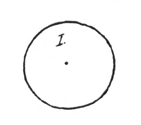
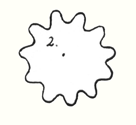
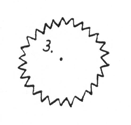
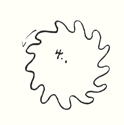
But we can go further. Let us picture to ourselves a less simple variation (4). The form moves in one direction and becomes action. If we live in this form we have the feeling that it advances, that it moves. In the forms themselves we find the quality of movement. I have here made a simple sketch of something that will appear in a complicated form in the building, but you will find that there is an absolute correspondence. Passing from the entrance at the West and thence towards the smaller structure (at the East) you will find that all the forms in the interior will evoke the feeling that the whole structure is proceeding from the West onwards to the East. This is expressed in the forms. At the West you will feel in thought that you are within a vehicle that is bearing you to the East. The very essence and meaning of these relief variations is that they do not merely appear as dead, dynamic or mechanical forms; we seem to enter a vehicle that bears us onwards. In a spiritual sense we shall not "rest" in our building; we shall be led onwards.
From this you will realise that the basic character of the forms here is quite different from the forms of the three stages of architectural thought which I have described. Up to our time architectural thought has been concerned with the qualities of lifeless, mechanical rest. Now, however architectural thought becomes the thought of speech, of inner movement, of that which draws us along with it. This is what is new in the whole conception, and the basic form must of course correspond to it. In what way does the basic form correspond to it? Now I have said that the most intimate of all impressions is that of the Self, the Ego, as expressed in the circle or sphere. Why is this? It is because the simple circle or sphere is of all forms the most easily perceptible. It is an absolutely simple matter to recognise a circle. All that is necessary is the most trivial thought that everything is equidistant from the central point. As soon as we picture to ourselves points standing at an equal distance from this centre, we have the sphere, or circle. It is the very easiest process that can be carried out in thought. As form, then, the circle is the simplest of all entities. This is also in accordance with external reality, for the Selfhood in every being, from the simplest cell to the complex human being, is the simplest of all impressions, just like the circle or sphere. Behind all this there is something much deeper and I want you now to follow me in a thought that will lead those who really understand it, to great profundities.
Now the form of
an ellipse is more complex than that of the circle. I will
draw the form of an ordinary ellipse. It need not be exact
but merely have the general character of an ellipse. The
simplicity of the thought is no longer there when we pass to
the ellipse. Although the ellipse is still spherical, we have
no longer the nature of equality as in the case of the
circle. Here I must ask those who have studied geometry
— although for politeness sake we will assume that you
all know a little of geometry though you may have forgotten
some of it — to try to understand the following ideas.
There is also order and regularity in the ellipse. Just as the
circle is related to one point, the ellipse is related to two.
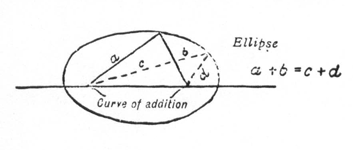
In the case of the circle there is no such feeling of satisfaction, for the circle is so immediately obvious. The ellipse causes us greater joy because there we have to be inwardly active. The more one is inwardly active, the greater joy one has. What is often so difficult to realise is that man, in his inner being, craves for activity. If he wants to be lazy this is merely an affair of his conscious life. The astral body is not only wiser, but also more industrious and would like always to be active.
Now there is
another line consisting, of course, always of two portions.
Those who have studied geometry will know that the
hyperbola consists of two symmetrical curves.
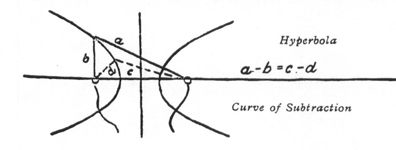
Man is thus a mathematician in the substrata of his consciousness and by means of subconscious calculation we create for ourselves regularity of form. We add and subtract, but we can also multiply. Here again we have two points. Multiplying the one by the other we again get a line that looks somewhat like the ellipse but is not the same. This line contains an inner process of multiplication.

This line has something mysterious about it. The circle is a simple entity, the ellipse already more complicated, the hyperbola still more so, for I do not think that the ordinary person sees only one single line in the two curves. The ordinary intellect believes there are two curves. The ordinary intellect believes there are two lines, but in reality this is not so. The other line is mysterious for another reason, for according to what is produced by multiplication the line is changed into this curious form. It is the curve of multiplication, the curve of Cassini, the lemniscate which plays so important a rôle in occult investigations. The line can develop in such a way that it assumes these forms. There are two lines, you see, but in the inner sense there is really one line, and when we feel it as one line in the astral world we know that this form (o-o) is only a specialisation of this form ( ∞ ). But now think — this form ( ∞ ) disappears into the fourth dimension— then appears again and enters the physical world. It is an unity because it ever and again disappears into the fourth dimension. This multiplication process has really three different forms.
We have
therefore a line of addition, a line of subtraction, a line
of multiplication. Someone may say that there must then be a
line of division, the fourth method of calculation.
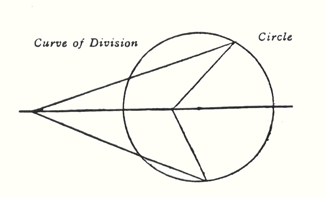
We add and get the ellipse.
We subtract and get the hyperbola.
We multiply and get the curves of Cassini, the Lemniscate.
We divide and get the circle.
Now we have something very remarkable indeed. When we really try to penetrate into the depths of nature they appear before the soul in all their wonder. The circle appears to be an utterly simple entity but it is, nevertheless, full of mystery. The circle can also be understood by taking two points and dividing, and inasmuch as the same result is arrived at, we get the circle. The circle is thus something very remarkable. It is the simplest of all entities and yet it is the product of an occult process of division that is brought into consciousness. It is just the same in the case of the self of man: the ordinary self is the simple entity and the higher self the mysterious entity resting in the depths of being — a self that can only be found when we transcend its limits and pay heed to the world with which it is connected. The circle is the same whether we say that it is the simplest of all forms or that the product of division from two points is always the same. Just as we have the same circle, so we have within ourselves a duality: something that belongs to everyday life and is readily perceptible, and something that we only grasp when we go out to the whole universe, conceiving of this entity as the most complicated product of the great cosmic struggle where Ahriman and Lucifer carry out the division and where our own higher self has to maintain itself as the quotient if it is ever to come to expression.
Portions of the ellipse and of the hyperbola and also of the curves of Cassini will be found everywhere in our building, and your astral bodies will have plenty of opportunity to make these calculations! Here I will only mention one instance: when people go into our building and stand in the gallery where the organ and the singers will stand, their souls will be able to carry out this process of multiplication. The soul may not do so consciously but it will feel this process in the depths of its being, because this is the line of the structure around the organ. This line will be found in many places in the building.
After what I have now told you about the twofold meaning of the circle you will be able to realise that when you enter the building from the West and feel yourselves surrounded by the circular structure, by the cupola above, that here is the image of the human self. But the other smaller space in the East is not at first sight so intelligible. The smaller structure will seem to be full of mystery because, although its form is also circular, it must be conceived of as the result of a process of division and it only outwardly resembles the larger space. There are two circles, but the one corresponds to the life of everyday and the other is connected with the whole cosmos. We bear within us a lower self and a higher self. Both again are one. Thus our building had to be a twofold structure. Its form expresses — not in any symbolical sense but in its very being — the dual nature of man. When the curtain in front of the stage is open we shall perceive an image of man not only as he is in everyday life, but as complete man. The forms themselves express a movement from West to East, the path of the lower to the higher Self. All that I have told you can actually be felt in the forms. The erection of a building of this kind reveals how the spiritual form of nature and the higher spiritual world can be expressed. Nobody who begins to think out all kinds of ingenious interpretations will Understand our building. It can only be understood by a living feeling of the development and being of the forms. For this reason I do not want to describe the building pictorially but to speak of the mode of its development, how spiritual being itself has become form and movement and has flowed into it. Suppose anyone were to look at the interior and begin to speculate thus: 'Yes, two cupolas, two circular structures — lower Self, higher Self; a lower Self, a higher Self — a unity.' This may be a neat interpretation but it would be of no more value than if it were said that Maria and Johannes Thomasius in the Mystery Plays are really one being. This is a mere speculation, for it results in an abstraction. The unity lies in the living 'becoming.' Naturally the living powers of becoming can bring forth both Maria and Thomasius but only as the result of a differentiation. Even in similarity the true occultist will always seek for diversity, for it would be false occultism to desire always to lead back diversity to unity. Hence the example of the circle. The circle is the simplest of all entities, where all points are equidistant from the centre — but it is also the result of division. In the circle we have something that is a unity in the outer world and complex in the spiritual world.
These are some of the remarks I desired to make. On another occasion I shall speak further on these matters. I shall now speak briefly of other things.
Man, as he
enters the world, is really a highly complicated being. When
he enters the world — as I have often said — he
cannot at first stand upright; lie crawls, and at the very
beginning of his existence he does not even crawl. Gradually
he learns to control the forces which make him able to stand
upright.
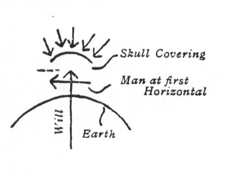
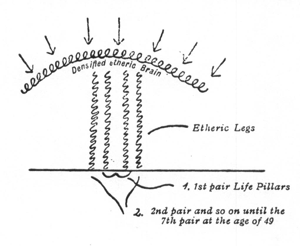
As a result of this the etheric head is densified and as a result of the formation of the brain there arises in the etheric body, in our age as well, the densified etheric body. This does not only take place in childhood but as man passes through seven life periods (from the first to the seventh year, from the seventh to the fourteenth year and so on) new lines are formed, lines of different forces which pass upwards. So that when we have reached the age of full and complete manhood — when we have passed the fiftieth year of life — we have added new pairs of pillars to that first strong pair formed during the first seven years of life. They appear in the etheric body in different colours. We strengthen our etheric sheath every time we develop these 'life pillars' — for so indeed they may be called. After the first period of seven years the first pair of life pillars is completed, at the fourteenth year the second pair, at the twenty-first year the third pair, and finally, with the forty-ninth year, the seventh pair. Each pair of life pillars makes our etheric skull-covering more secure. Man passes through his life and after every seven years raises within himself different pillar formations which bear his skull. When we have understood this we shall have a living conception of the inner form of the larger section of our building. We enter at the West and say to ourselves: 'Up to the first pair of pillars we see how man develops in the first seven years of his life; the second pair of pillars denotes his development to his fourteenth year, then on to the twenty-first year and so on.' And the etheric sheath of the head is always around us. Man, the living being, is poured out into the forms as an etheric being.
The advance from Gothic architecture to that of Spiritual Science may be described as follows: Gothic architecture contains the prayer: 'O Father of the Universe, may we be united with Thee, in Thy Spirit.' Those who know what this prayer contains, who really understand the living development of Spiritual Science, will solve the riddle of the evolution of man. And then, when the forms of architectural thought strive to be united with the Spirit—expressing this striving in their very being — man will feel how he has been permeated with the hidden Spirit and can have around him a building which is a direct expression of the living, inner development of his being.
'We dwell in the land, but the Spirit is among us.' This is the Greek thought of architecture.
'We dwell for a season in the sanctuary and the Spirit comes to us.' This is the thought behind Christian architecture.
'We dwell for a season in the sanctuary, but we uplift the soul by raising ourselves to the Spirit.' This is the thought behind Gothic architecture.
'We enter with reverence into the Spirit in order that we may become one with the Spirit poured out around us in the forms — the Spirit that moves and is active, because behind the Spirits of Form stand the Spirits of Movement.' This is the thought behind the new architecture.
Existence thus advances through earthly evolution and it is man's task to understand the inner meaning and purport of this existence. He only advances in the wake of true evolution when he endeavours, in every epoch, to experience what the spiritual world bestows in that epoch.
Why do our souls pass through different, successive incarnations? Not in order that we may repeat the same experiences, nor that we may pass through re-birth, re-naissance, again and again, but in order that we may assimilate, ever and again, the new that pours into our souls from out the spiritual worlds. We are standing at a definite point in the evolution of humanity in the sphere of art and in many other spheres of spiritual life — at a point where the Spirit speaks clearly to us of new riddles. And just as in the time of the Renaissance man was destined primarily to orientate himself to the past in order to work his way through to the new, so it is with our own external knowledge and perception of the universe. All that has been produced by the modern age since the sixteenth century is only the preparation for a living experience of the universe in its forms and movements which now stand before us as riddles.
This, then, is all for to-day. In another lecture I will try to approach questions of a still more intimate character — questions relating to the living soul of nature in connection with colour and the art of painting.
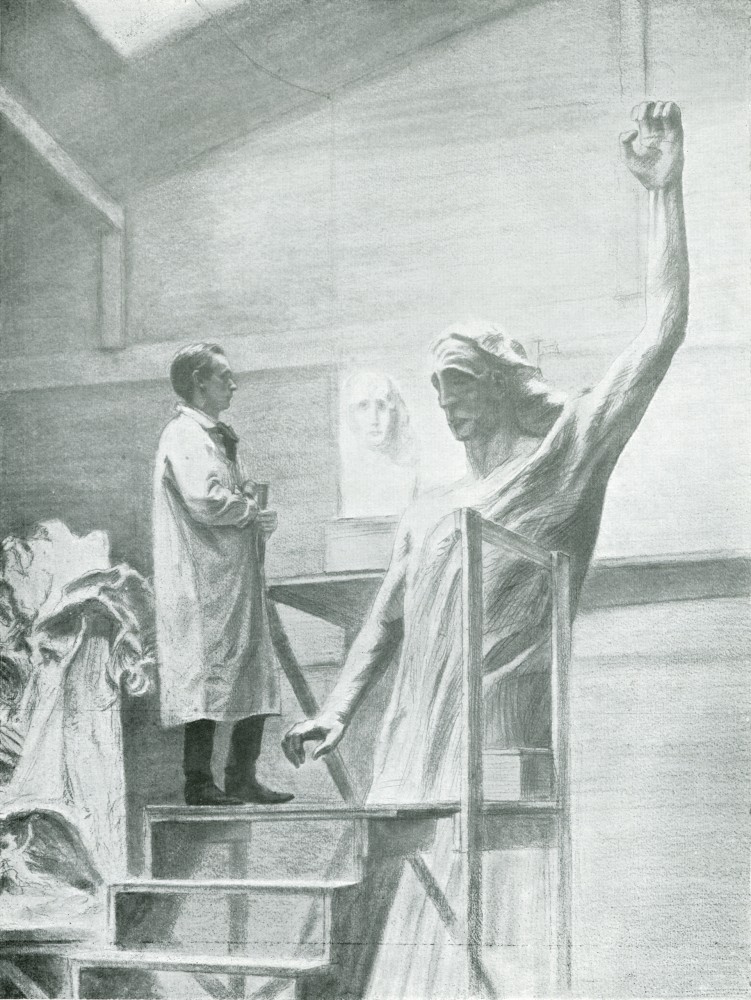
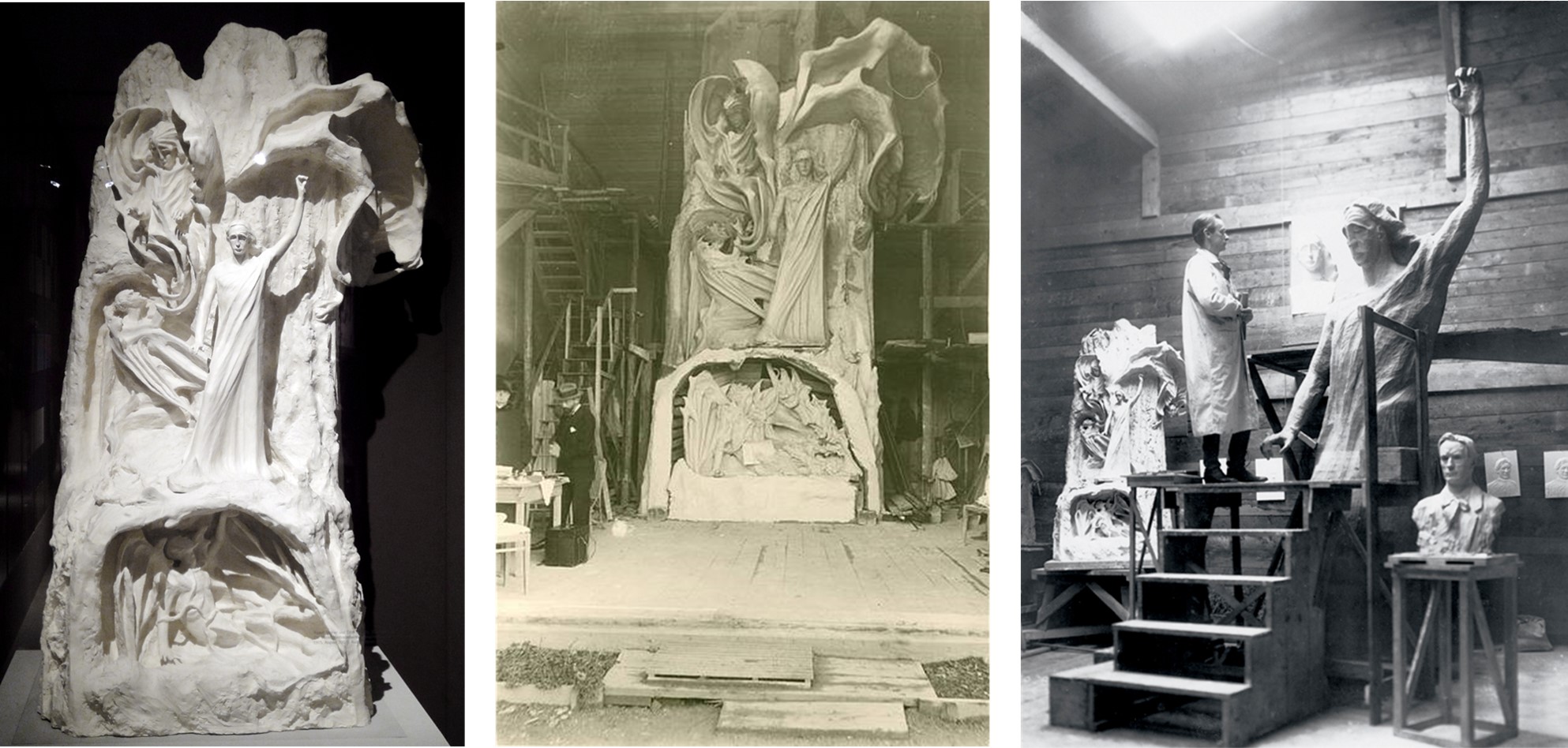
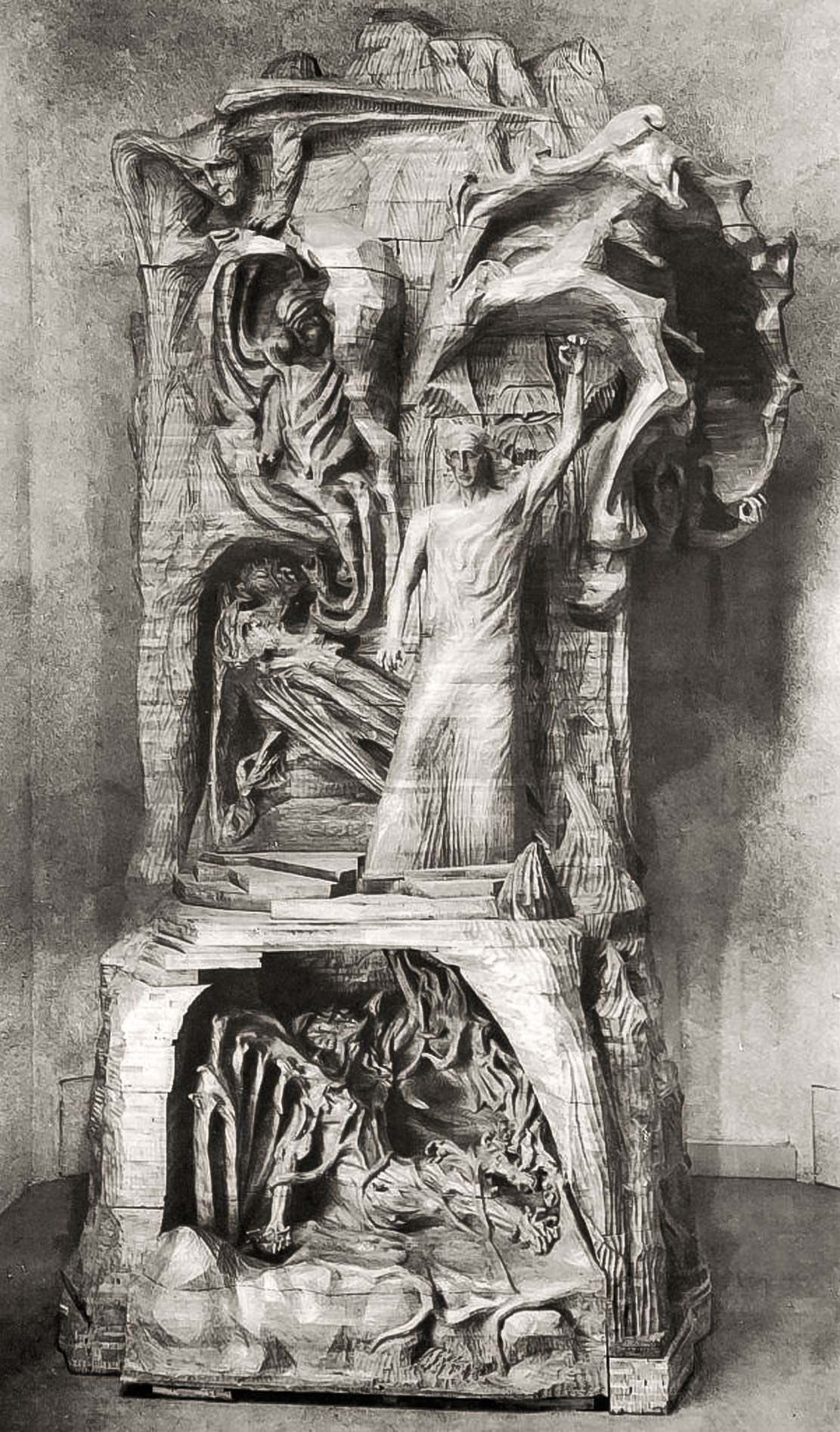
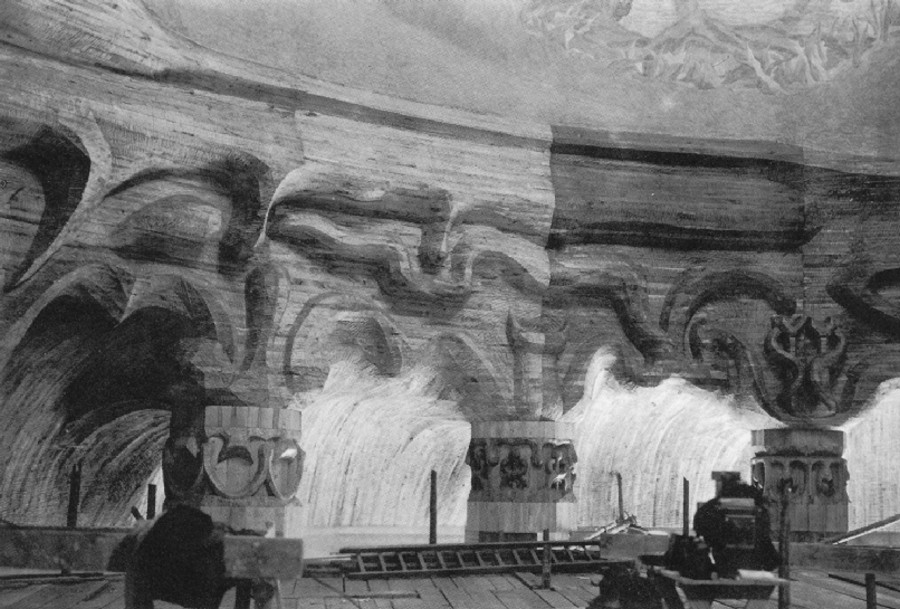
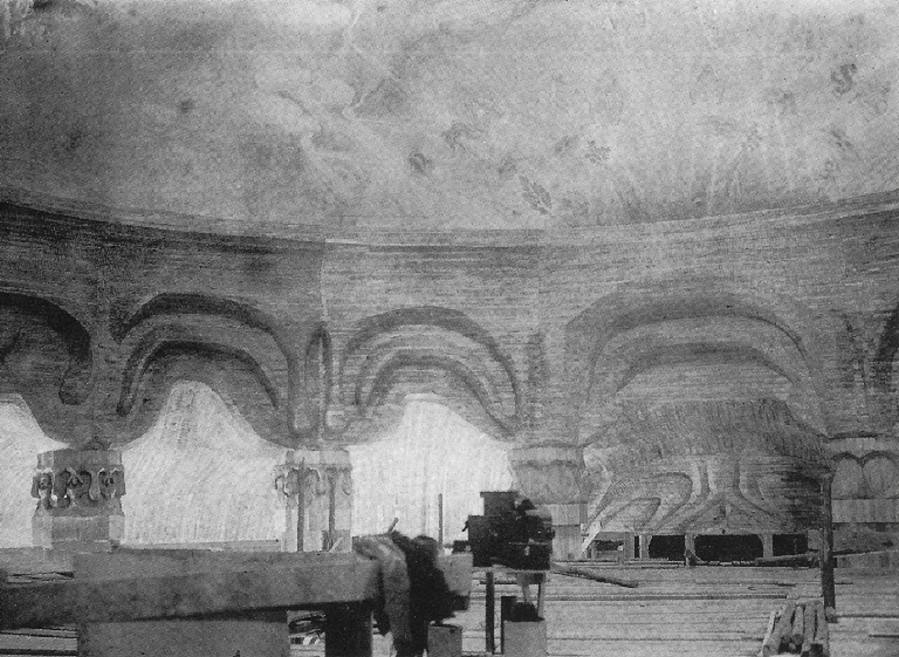
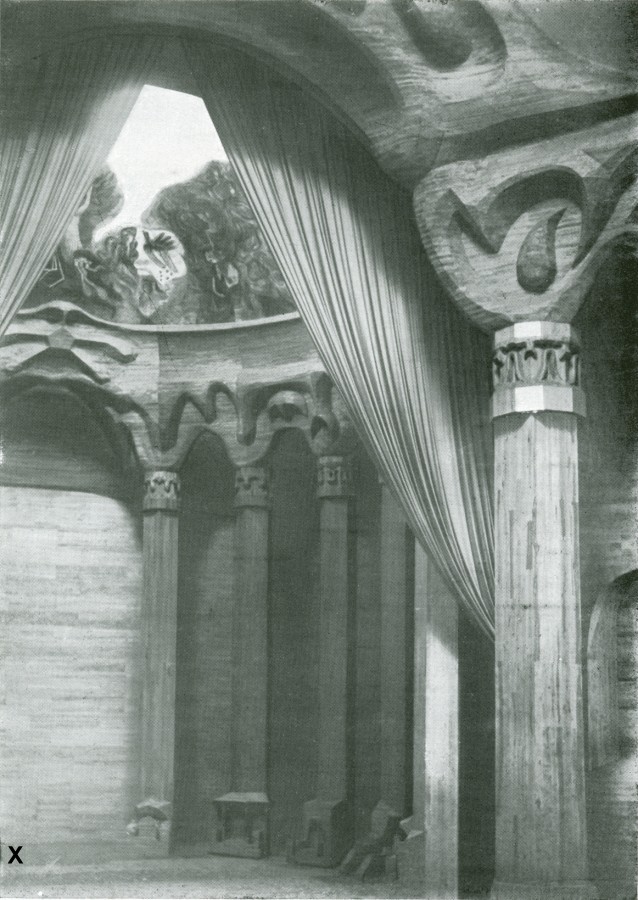
5 July 1914, Dornach
In the last lecture we spoke of the Spirit which should pervade the forms in our building. From all that has been said you will have gathered that these forms are no more the result of imitation of the external physical world than of mere speculation. Your feeling will have been that the forms have been derived from the spiritual world of which man is an integral part and of which he may hope to become conscious in the development of his knowledge of Spiritual Science. I want to remind you once again of an important fact, of which mention has already been made, namely, that human life runs its course in periods of approximately seven years each, and — as I tried last time to explain to you from spiritual-scientific cosmology — when we observe the whole course of these periods of seven years, we may say that after each period a certain support is added to man's being. When he has passed through seven such periods, therefore, he has reached approximately his fiftieth year, he possesses seven pairs of these 'life-supports.'
If we were now to imagine ourselves entering the building from the West, in the first two pillars we have the expression of the supports which man has raised in his own being after the first period of seven years has run its course; the second pair of pillars are an expression of the supports he has added after the second period of seven years; and so it goes on, only it must be remembered that in man these supports are intermingled, whereas in the building they have had to be placed one behind the other in space. We may then be permeated with the feeling that when we pass through the building from the West towards the East, all that works upon us from left and right is a revelation of processes in human life itself. This shows us that there are firmly established cosmic laws of which man is a part but which are infinitely deeper than the so-called 'natural laws' of the outer physical world, and furthermore that the forms in our building have been evolved from these deep cosmic laws.
To study every detail from this point of view would lead us very far, although it could be done. In the present materialistic epoch, where there is no knowledge of Spiritual Science, there will be little understanding for these deeper laws of 'being and becoming.' We may therefore find ourselves faced with the question — and it is a wholly understandable one from the point of view of external knowledge — 'Why are the columns made of different kinds of wood?' There is no allegorical or symbolical meaning in this, and anyone who raises such a question merely proves that life has afforded him no opportunity for the contemplation of deeper cosmic laws. The only rejoinder we can make is this: 'Why, then, do you consider it necessary for a violin not to have only A strings?' A man who wanted to use only A strings on a violin would be in exactly the same position as one who — perhaps quite unconsciously and naïvely — were to ask as the result of superficial knowledge, why our pillars are made of different woods.
We can develop these matters slowly, for we shall often meet together here. We can allow subjects that may prove fruitful to enter gradually into our feelings. To-day, therefore, I only want to speak of one matter that will help to stimulate our perception of what underlies the laws of true aesthetic form, on the one hand in the cosmos, and on the other in the microcosm, in the constitution of man. Before very long, the so-called science of to-day will undergo an overwhelming expansion, and only then will there be understanding of the true and deeper laws of aesthetic form.
In order to
evoke a concrete perception of what I have here mentioned in
mere abstract words, let us consider the following. I am
going to place before you something that corresponds to a
cosmological fact, a mighty cosmic fact.
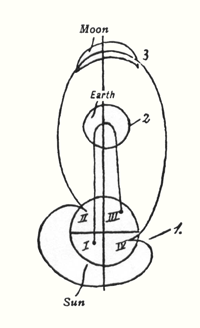
Now these three heavenly bodies (see diagram) stand in a certain mutual relationship to each other; they reveal their activities to each other and I want to speak of one particular aspect of these activities. To this end I will first divide the Sun diagrammatically as it actually appears to the occult seer when he directs his attention to these things. The Sun is seen divided into a kind of cross, into four chambers. The remarkable thing is that in the first moments of vision we see a kind of streaming current, but closer scrutiny reveals the fact that here we have to do with hosts of beings passing to and fro. We can see such a stream of spiritual beings passing from a certain "chamber" of the Sun to the Earth, penetrating the Earth and vitalising the Earth with solar essence, that is to say, with the spiritual force of the Sun, and thence streaming to their own chamber in the Sun.
This is cosmic reality but one sees still more — one sees migrations of hosts of spiritual beings who are flowing around and through the Moon (see diagram). They proceed from another chamber of the Sun: but they also flow in the other direction and pour through the Moon. Up to this point we are perceiving the activities of the inhabitants of three chambers in the Sun. Another migration or stream arises from the fact that these beings always return to the Sun after having passed through the Moon; thus a double stream has arisen. On the one hand the beings return into the fourth chamber in the Sun after having poured through the Moon, but another stream is formed because certain beings do not take part in the migration to the Moon; before reaching the Moon they turn back again to the Sun. This configuration reveals to us a kind of mirror-image in the cosmos, but we will leave this image out of consideration for the moment. It would be formed by a symmetrical expansion of the figure that is engraved there in the cosmos. This means, in effect, that there is revealed to clairvoyant consciousness a marvellous combination of forms, a figure engraved in the cosmos representing the interplay between the forces of Sun, Moon and Earth.
Now I will draw
the diagram rather differently, with the Sun rather turned
(Diagram II). The cross must also be turned.
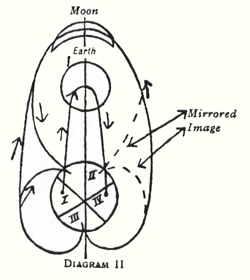
Now I will draw the diagram again differently (Diagram III). Here I have assumed hypothetically that Ahriman and Lucifer have entered, bringing disorder in their train. I will draw the Sun, Moon and Earth more irregularly and again trace the connections between them. What have I now drawn? Exactly the same thing as in the other diagrams, only somewhat distorted as a result of the intervention of Ahriman and Lucifer. I have now drawn a sketch of the blood circulation in man, a sketch of how the blood flows from the left ventricle of the heart through the body, on the one hand through the brain on the other through the rest of the body, returning as venous blood; you also see the course of the small circulatory stream through the right ventricle and lungs back again to the so-called left auricle.
Thus we can
read from the cosmos what man is as a microcosmos, only it
must be remembered that Ahriman and Lucifer have approached him.

If a figure were made of this diagram — that is to say, a figure copied from the cosmos and expressed in some motif — we should have before us a profound cosmic mystery merely in the combination of form. When a certain combination of lines underlies a figure of this kind — where perhaps only a few of these lines are expressed and the others drawn in quite another way — those who have real feeling and not merely intellectual understanding, will perceive a cosmic mystery in the very form itself. They will say to themselves: 'What is it that this form expresses? I do not actually know, but I feel that it expresses a mystery.' It is this that inspires our souls and makes our hearts glow when we look at certain forms. We cannot always be conscious of what lies behind them, but our astral body, our subconscious being, contains the mysteries of the cosmos and senses them in the depths just as it contains the secrets of mathematics, as I told you in the previous lecture. When a man says, 'I feel beauty here, but I cannot explain to myself what it really is,' something is taking place in his astral body. This he may express by saying that he senses the existence of deep and mysterious secrets of the cosmos which do not take the form of ideas and thoughts but are expressed in a feeling, 'Ah, how beautiful this form is.' The reason why he feels this as warmth pouring through his heart and soul is that if he were as conscious in his astral body as he is in his ego he would have a deep knowledge of the cosmos.
These things must teach us to understand how art has gradually developed in human evolution and to realise that true works of art in the Goethean sense are 'a manifestation of higher laws of nature than the ordinary intellect of man can divine.' We find an inkling of the truth of these things more especially when we go back to what modern opinion holds to be the "primitive art" of earlier periods of human evolution. This is because in those olden times a certain primitive, atavistic clairvoyance was a common attribute of humanity and because man then created forms from out of this clairvoyance. Many of the forms to be found in primitive art can only be understood when we realise that they were the outcome of this primordial clairvoyant consciousness. Men experienced the content of their astral bodies as living movement, tried to express it in a kind of noble dance, and then converted it from the Dionysian dance into Apollonian design and painting. Such is the origin of certain forms of early art which often seem to us merely primitive, but which in truth have sprung from a deeper understanding of the spiritual world imparted by the clairvoyance of those times.
This, I think, will show you that in the sense of true, genuine art, the easy phrase 'there can be no disputing about taste' is wholly incorrect in its ordinary sense. Fundamentally speaking, of course, one can dispute about everything, even about mathematical principles. When one man applies a mathematical principle and gets a different result from another who also applies it, disputes can naturally arise and even become acute, but one of the two has made an error. The error, of course, is not so easy to discover in the case of beauty or art. Nevertheless man can attain to a point of view which convinces him that the forms and laws of true art are firmly established and based upon the deeper laws of cosmic being. Perhaps it may be admitted that the principle ' there is no disputing about taste' only penetrates into life by dint of effort, that it is a conception only to be evolved very gradually. But in the course of his life a man can be convinced of the truth of it when he realises that art is a manifestation of higher laws of nature which without art would never be revealed. Here again I am using Goethe's words. Man can indeed be convinced that art is this manifestation of higher laws of nature about which there can fundamentally be no disputing.
In the light of what now should be living within us, not so much as thought, but as feeling, we must gradually be able to work our way to another perception. What is really happening to us when we delight in forms that are truly artistic? We are passing out of ourselves, penetrating with the soul into something that is real, outside ourselves. Therefore it is not at all unnatural that in a building which belongs to the present and future we should set out in full consciousness to create forms which will help man to conquer the consciousness of merely physical and material actuality and feel himself expanded out into the cosmos through the architecture, sculpture and all that this work of art may contain. Much will have to be done, however, before this feeling will be able to penetrate into every sphere of art and be admitted by modern science. Darwinism, and all that it brought in its train in the nineteenth century, rendered great service to the progress of human knowledge and culture, but it gave rise to many one-sided conceptions, for instance, in the law of so-called "selection" which has been laid down as a universal law, although it only holds good in one connection. The knowledge of this law is very important, but to lay it down as a universal law is the result of distorted, one-sided conceptions. People have been led to think somewhat as follows. They ask, 'Why is it that the structure of living beings is contrived in accordance with expediency? What is the origin of this?' The monistic materialist of the present day answers: 'We are no longer as stupid as our ancestors. We have great intelligence and do not therefore believe that some spiritual being or other has endowed living organisms with this "expedient" structure. It is part of nature that the expedient and the inexpedient (the fit and the unfit) should originally have arisen, concomitantly. These two elements then entered into the struggle for existence where the fit conquered and the unfit was exterminated. The fit passes down through heredity, so that after a certain time it alone remains.' The 'fitness' of the organic structure was thus explained by the law of causality.
This conception is then applied in a special instance. Some creature lives in a certain environment and has this remarkable characteristic, that its colouring is the same as that of its environment. Certain creatures live, let us say, in sand of a particular colour. In such cases observation shows that the creatures take on the colour of the sand. Those who adhere to the theory of selection and expediency say: 'It is expedient for these creatures to have the colour of their environment, for their enemies do not see them and hence cannot pursue them. They are not destroyed. They have this advantage over other creatures whose colour differs from that of the sand. Once upon a time there were creatures who colours resembled the sand, while others were of every possible hue. But these latter were seen by their foes and destroyed; they were at a disadvantage in the struggle for existence.' The others, however, who were, by chance of the same colour as the sand, remained, and this quality was transmitted to the following generations. The creatures who were differently coloured died out and those like the sand maintained themselves in the struggle for existence.' This is a highly plausible train of thought and it has dominated the minds of men for decades. In sandy places hosts of these tiny creatures of exactly the same colour as the sand are to be found. According to materialistic, monistic Darwinism they are supposed to have originated as I have described. But actual facts upset the conclusion, for, in spite of it all, as soon as these creatures show themselves they are destroyed by their foes. The whole conception is based upon a chain of argument that does not reckon with the actual facts. All these materialistic speculations and fantasies will one day be replaced by true insight which may indeed seem grotesque and paradoxical to many people but which will explain, for instance, why the polar bear is white and not black or brown. The insight will arise that there is an astral nature, that every animal has an astral body and that soul processes have their seat in this astral body. The greyish coloured creatures in the sand have of course no ego, but they have an astral body, primitive though it may be. An interplay arises between this astral body and the colour of the environment, and the effects produced by this interplay between the greyness, let us say, of the environment, and the astral body, pass into the dimmer consciousness of the astral body and permeate the whole being. It is just as if you were to look around here and say, 'This is wood, I know that it is wood.' The creature lives in the sand, its astral body is permeated with the colour of the sand and the consciousness of the colour of the sand' flows through its whole being. It takes on the colour, saturates itself with the colour of the environment which has been consciously absorbed. The colour is of course modified by every struggle arising between the immediate colour of the environment and the direct light of the sun. The influence of the direct light of the sun on the astral body, however, is such that, by way of the soul nature, something that in turn streams out and permeates the the whole being enters into the astral body. In the very colours of birds' feathers and skins of animals man will recognise the deeper effects of the consciousness, which is the result of the interplay between the astral body and the environment. The living being lives and moves in the flowing ocean of colour and identifies itself with this flowing colour essence. The human being also does this below the threshold of his ego, but in a higher sense. Our life, therefore, is bound up with the life of the flowing sea of colour. As human beings we have the advantage of the animals in one thing only. I can now do no more than hint at it. Think, by way of comparison, of certain animals which always swim under water and never come to the surface. They have water in their environment. They adapt themselves to what they take into themselves from the water. Others have to come to the surface and they too adapt themselves to what is above the surface of the water. Instead of the water, think now of a flowing sea of colour and light. All animals live, as it were, under the surface of the sea of colour and light, hence they adjust their outer covering primarily in accordance with this flowing colour and light. Man with his ego consciousness stretches out beyond the sea of colour and light and the very fact that he can do this gives him his ego consciousness. When man's colouring is influenced, as in the different races, the influence is not, in his case, the outcome of colour and light, but of the conditions of warmth and climate. The reason why humming birds in certain regions are decked with such a variety of colours is very different from the reason which causes human beings in the same region to be of a negroid black. The birds have been worked upon by colour conditions, and man by the warmth condition, because, in effect, the human being with his ego rises above the sea of colour and this only works in his astral body. Otherwise — to use a radical and therefore paradoxical expression — if the agricultural labourer who is perpetually surrounded by green had no ego whereby he reaches beyond the sea of colour, he would go about with a greenish skin; and the skin of the city man, living perpetually among grey houses and seldom leaving them, would have a horrible greyish tint — that is to say if primordial forces were at work., Our astral body none the less is immersed in the flowing sea of colour, but all that the astral body absorbs from this sea of colour has taken on a different activity. Our hair is not coloured, nor if we had feathers would they be coloured by what the astral body absorbs; instead of this, we have perceptions and feelings in connection with colour without diffusing the colours through our being. If we were simply to absorb the green or blue or red into our astral body and diffuse them through our being, thus giving ourselves the colouring of the outer world, we should have quite a different relationship to the world of colour than is actually the case. We do not, however, do this. We absorb the colours into our being in a spiritual sense, so that blue, for instance, becomes the expression of rest; red the expression of all that is passionate, fiery. Colour is changed into flowing perception or feeling in man, because he reaches out with his ego beyond the flowing sea of colour. Here is a proof that we float in the colour essence of the cosmos and that even when we are merely contemplating the colours of nature we must try to perceive in the aesthetic sense, to establish standards of beauty. This however implies that we must learn to grow into colours, to live in them as within our own element. One seldom finds this feeling for colour, even among people who think a great deal about art. Take, for instance, Hildebrand, who is an exceedingly good artist and who has written an ingenious book on the subject of artistic forms. We read there that colour alone cannot suffice for the real portrayal of things; there must first be the design, the drawing. This, however, is not correct. Hildebrand thinks that when he has a coloured wall in front of him, he is simply looking at colour, possibly blue or red, whereas if he draws contours or designs upon it he has an expression of something. If a surface is covered with blue or red it does not express anything definite — at least according to Hildebrand. Nor this is not the case. A surface covered with blue produces an impression which may be expressed in the following way. Instead of the area that appears blue, the feeling arises that blue takes one into greater and greater depths, to distances ever more remote, to the Infinite, as it were. The blue colour takes one along with it — on and on. Red seems to fight with one, to approach.
This of course is somewhat radically expressed, but the whole colour scale thus reveals itself as living being. Just as forms with clear contours express something definite, so does colour place before us something quite definite, differentiated. To fathom these things, however, will be the task of future Art — and in what sense? To understand this we will consider the real nature of the spirit of human evolution.
Human evolution proceeded from conditions of primitive, atavistic clairvoyant consciousness. Man gradually worked his way upwards through the different civilisations until, during the Graeco-Latin age, his ego came to birth in the intellectual or mind-soul. We are now living in an age when the ego rises into the consciousness soul (spiritual soul) and has then gradually to rise to Spirit-Self or Manas. In the ages preceding the birth of the ego, of the ego consciousness, art proceeded from direct inspiration which flowed into man from the spiritual world, and all the different forms in art were an expression of this. Suppose a man went out into the on-coming night and looked at the moon. The atavistic clairvoyant consciousness he still possessed gave him the knowledge that here was a revelation of the connection between his brain and the moon, that his lungs breathed in all that the earth's being was communicating to him. The sun had set, but he knew that in the pulsating beat of his heart he bore the sun workings within him. Then man felt — or rather he 'saw' it in the atavistic clairvoyance of those ancient times — he felt: 'Yes indeed there is a connection between earth, sun and moon. Spiritual Beings are hovering up and down between the sun and moon!'
"Like heavenly forces rising and descending,
Their golden urns reciprocally lending."
(From Goethe's Faust. Scene I.)
... Then came the age in human evolution when this old clairvoyance gradually passed away; man entered into a condition where he could only perceive the external world of sense. Nothing flowed into him from the spiritual world and it became necessary to resort to a different realm. Every artistic impulse lived originally in the moving being of man himself. He tried to imitate or copy what he perceived in the cosmos by expressing through his hands and with his hands the form that he felt to be living in his hands like a cosmic force. At that time he had to translate into form what he expressed in gestures. It did not occur to him to copy or imitate an object in the external sense. All that lived and pulsated within him, flowing and breathing into him from the cosmos, developed into art without any mere imitation, because the inner life surging within him used him as an instrument. He was the instrument guided by the cosmos itself.
This was no longer the case after the old clairvoyant consciousness, which linked man to the cosmos, ceased. Imitative art came into being, for man no longer possessed within himself the power which guided the lines and other factors of art; he no longer felt, I will draw near to the Godhead. 'There is the Godhead and I will approach.' When a man felt himself rising to the Godhead he was conscious of the perception of blue, and if he wanted to give expression to this feeling he used the colour blue. But if he was conscious of the approach of an enemy, an alien being bearing down upon him, then he used red. He experienced the flowing sea of colour within himself and there was no need to imitate or copy. This was no longer the case when atavistic connection with the cosmos ceased. Imitative art came into being and attained its summit, so far as sculpture was concerned, in the Graeco-Latin epoch, and so far as painting was concerned, in the age which marked the transition to the fifth Post-Atlantean period. To those who have eyes to see, external history would also be able to prove the truth of these things. Try to think why it is that peoples from Northern and Central Europe who came into contact with Graeco-Latin culture remained so long in a state of barbarism and could not find their way to art. The reason is that these Celtic, Germanic, Slavonic peoples had remained at an earlier stage of evolution than the Graeco-Latin peoples. They had not reached the stage of the full birth of the ego and understood nothing of true imitative art. They came along afterwards with a reinforcing impulse. Hence when we study the art of the Middle Ages we find that the significant elements there are not those of imitative art. The characteristic qualities of mediaeval art are to be found in architecture where man does not imitate but creates out of his inner being. It is only gradually that the imitative element in art entered into the northern peoples.
Nowadays, however, we are living in an epoch when man must again find his way into the spiritual world, when he must pass over from imitative art to a new form of artistic creation, when there must be a true renewal of art. The imitative arts reached their prime in the sculpture of antiquity, in Raphael, Michelangelo and others. Something different hovers before us now — a consciousness that penetrates into the spiritual world and at the same time brings down all that exists in forms and colours in the cosmic ocean flowing spiritually around us. A beginning must be made. Something that is not achieved by imitation and which is all around us must be brought down from the spiritual world. I have already spoken of the extent to which this conception has flowed into certain forms in our building and on another occasion we will speak of the new conception of the art of painting. To-day I only wanted to try to deepen the feelings and perceptions which must be ours if we are really to understand the transition which must come about before the old forms of art can pass over to the new.
I hope that those friends whose unselfish and devoted labours are revealed each day that passes, will work in such a way towards a mastery of the forms which are necessary to our building, that although it be only a primitive beginning, there will none the less be a real beginning of a spiritualised art. I hope that they will find more and enthusiasm, greater and greater joy, in the consciousness that the World-Spirit demands us to help in the task of establishing in human evolution those things which must be established in our own fifth epoch and during the transition into the sixth. If we understand this, we link ourselves with the World-Spirit working in human evolution, of Whom we try to gain knowledge through true Spiritual Science. All the impulses of this Spiritual Science can pass over into artistic feeling, artistic activity and experience of the cosmos. True enthusiasm and devotion are necessary, but they will grow in us if we lovingly rise to the Spirit Who has guided mankind from the beginning of evolution. That Spirit will not forsake us if we dedicate ourselves to Him with upright hearts and in the real sense — if our labours are not a sentimental prayer, but a true one arising from the power flowing into our inner being from the World-Spirit Who is leading us, and if we are filled with the inspiration of the knowledge that we allow the work of our hands and souls to be guided by the power of the Spirit within us.
In this sense, then, let us continue our work.
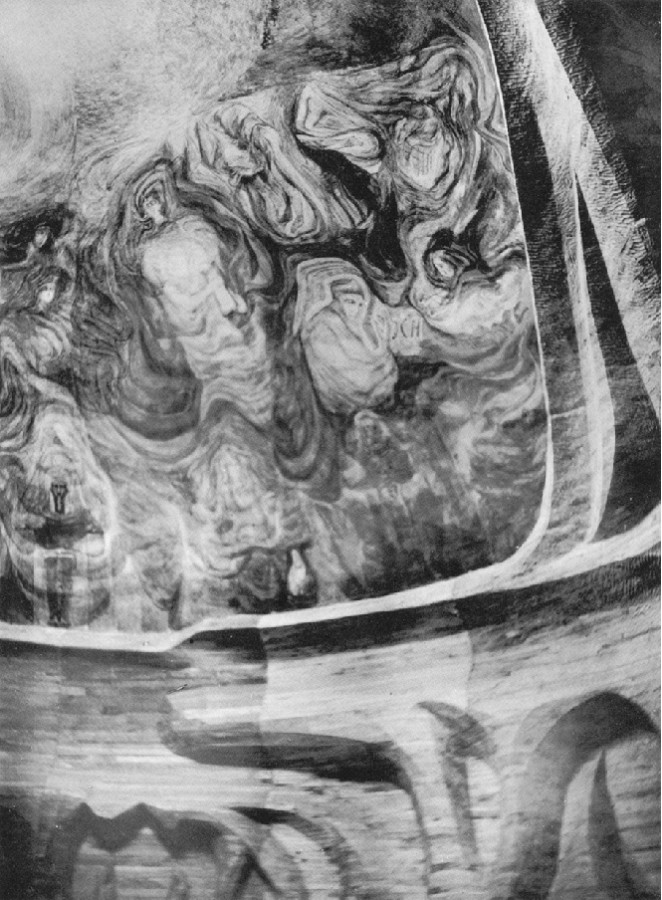

26 July 1914, Dornach
To-day we will continue our study of subjects connected with art. The lectures are meant to help us in regard to the kind of thoughts which should permeate the work before us. If we would couple right thoughts with the task which we are here beginning in a primitive fashion, the necessity arises to bring before the soul many things that impress us when we study man's achievements in art and their connection with human civilisation.
Herman Grimm, the very intuitive student of art in the nineteenth century, made a certain apparently radical statement about Goethe. He spoke of the date at which humanity would first have developed a real understanding of Goethe, placing it about the year 2000. According to Grimm's idea, therefore, a long time will have to elapse before mankind will have developed to the point of understanding the real significance of Goethe. And, indeed, when one observes the present age, one does not feel inclined to contradict such a statement. To Grimm, Goethe's greatest significance does not lie in the fact that he was a poet, that he had created this or that particular work of art, but that he always created from a full and complete manhood — the impulse of this full manhood lies behind every detail of his creative activity. Our age is very far from understanding this full manhood that lived, for instance, in Goethe. In saying this I have naturally no wish to speak derogatively of the specialisation that has entered into the study of science, which is indeed often deplored — for from one point of view this specialisation is a necessity. Much more significant than the specialisation in science is that which has crept into modern life itself, for, as a result of this, the individual soul, enclosed within some particular sphere of specialised conceptions or ideas, grows less and less capable of understanding other souls who specialise in a different sphere. In a certain sense all human beings are "specialists" to-day so far as their souls are concerned. More particularly are we struck with this specialised mode of perception when we study the development of art in humanity. And for this very reason it is necessary — although it can only be a primitive beginning — that there shall again come into existence a comprehensive understanding of spiritual life in its totality. True form in art will arise from this comprehensive understanding of spiritual life. We need not enter upon a very far-reaching study in order to prove the truth of this. We shall come to a better understanding if we start from something near at hand, and I will therefore speak of one small point in the numerous irrelevant and often ridiculous attacks made against our spiritual movement at the present time.
It is so cheap for people to try, by means of pure fabrications, to slander us in the eyes of the world, saying, for instance, that we are on the wrong track because here or there we have given to our buildings a form that we consider suitable to our work. We are reproached for having coloured walls in certain of our meeting rooms and we are already tired of hearing about the 'sensationalism' in our building — which is said to be quite unnecessary for true 'Theosophy' — that is how people express it. In certain circles 'true Theosophy' is thought to be a kind of psychic hotch-potch, teeming with obscure sensations, glorying to some extent in the fact that the soul can unfold a higher ego within. This, however, is really nothing but egotism. From the point of view of this obscure psychic hotch-potch people think it superfluous for a spiritual current to be expressed in any outer form, although this outer form, it is true, can only be a primitive beginning. Such people think themselves justified in chattering about these psychic matters no matter where they may be. Why, then — so they think—is it necessary to express anything in definite forms? We really cannot expect to find any capacity of real thought in people who hurl this kind of reproach at us — in fact we can expect it from very few people at the present time — but, nevertheless, we must be clear in our own minds on many points if we are to be able at least to give the right answers to questions that arise in our own souls.
I want to draw your attention to Carstens, an artist who made his mark in the sphere of art at the end of the eighteenth century as a designer and painter of decided talent. I do not propose in any way to speak of the value of Carstens' art, nor to describe his work — neither am I going to give you a biographical sketch of his life. I only want to call your attention to the fact that he certainly possessed great talent for design, if not for painting. In the soul of Carstens we find a certain artistic longing, but we can also see what was lacking in him. He wanted to draw ideas, to embody them in painting, but he was not in the position of men like Raphael or Leonardo da Vinci — or to take an example from poetry — of Dante. Raphael, Leonardo and Dante lived within a culture that teemed with import — a culture that penetrated into and at the same time surrounded the soul of man. When Raphael painted his Madonnas they were living in men's hearts and souls and in the very highest sense something streamed from the soul of the public in response to the creations of this great artist. When Dante set out to transport the soul into spiritual realms he had only to draw his material, his substance, from something that was resounding, as it were, in every human soul. These artists possessed in their own souls the substance of the general culture of the age. In any work of the scientific culture of that time — however much it may have fallen into disuse — we shall find connecting links with an element that was living in all human souls, even down to the humblest circles. The learned men of the spheres of culture where Raphael created his Madonnas were fully cognisant of the idea at the back of the figures of the Madonna, nay more, the idea was a living thing within their souls. Thus artistic creations seem to be expressions of a general, uniform spiritual life. This quality came to light again in Goethe as a single individual, in the way that was possible at the turn of the eighteenth and nineteenth centuries. So little is this understood in our times, that, in Herman Grimm's opinion, as I have already said, it will be necessary to wait until the year 2000 before the world will again reveal such understanding.
Let us turn again to Carstens. He takes the Iliad of Homer, and he impresses into his penciled forms the processes and events of which he reads. What a different relationship there is to the Homeric figures in the eighteenth and the beginning of the nineteenth century from the relationship that existed between the soul of Raphael and the figures of the Madonna and other motifs of that age! In the greatest epochs the content of art was immediately perceptible because it flowed from something that moved the innermost being of man. In the nineteenth century' it began to be necessary for artists to seek for the content of their creations by dint of effort and we soon find that the artist becomes a kind of 'cultural hermit,' one who is only concerned with himself and of whom people ask, 'What relationship is there between himself and his own particular world of form?' A study of the history of art in the nineteenth century would reveal the true state of affairs in this connection.
Thus there gradually arose, not only the indifferent attitude to art, but the cold one that exists nowadays. Think of someone in a modern city walking through a picture gallery or exhibition of pictures. The soul is not moved by what is seen, no inner confidence is felt in it. The person is faced by what really amounts to a multitude of riddles — to use a radical expression — riddles which can only be solved if to some extent penetration is made into the particular relationship of this or that artist to nature, or to other things. The soul is faced with purely individual problems or riddles, and the significant thing is, that although people believe they are solving the problems of art, they are, in the vast majority of cases, trying to solve problems not really connected with art itself — to wit, psychological problems. Such problems as: How does this or that artist look on nature — are problems of philosophy or the like and are of no importance when we really penetrate into the great epochs of art. On the contrary, when this penetration is undertaken, the problems that emerge not only for the artist but for the contemplator of the works of art, are truly artistic, truly aesthetic ones. For it is the manner that really concerns the creative artists, while the mere matter, the mere substance, is only the element that flows around him, in which he is immersed. We might even put it thus: our artists are no longer artists. They are contemplators of the world, each from a certain point of view and what they see, what strikes them in the world, this they contrive to shape. But these are theory, problems of history and so forth, while on the other hand our age has almost altogether lost the power — or indeed the heart — to perceive art in its essence, to perceive the manner, not the mere matter.
Our conception of the world—theoretical from its very foundations — is a good deal to blame for this. Practical as men have become in technical, industrial and commercial affairs, they have become eminently theoretical so far as their thinking is concerned. The endeavour to build a bridge between modern science and the conception of the world held by the artist is not only fraught with difficulty, but with the fact that so few people feel there is any need to build it. Words like those of Goethe: "Art is the manifestation of secret laws of nature without which they could never find expression" are wholly unintelligible to our age, although here and there people think they understand them. Our age holds fast to the most external, the most abstract natural laws — laws which are themselves based on utterly abstract mathematical principles — and it will not admit the validity of any penetration into reality which transcends all abstract mathematics or systems of that kind. No wonder our age has lost the living element of soul which feels the working of the very substance of world connections — the substance that must indeed well up from these world connections before art can come into being. The thoughts and ideas evolved by the modern age in regard to the universe are inartistic in their very nature — nay more, they even strive to be so. Colours — what have they become according to modern scientific opinion? Vibrations of the most abstract substance in the ether, etheric vibrations of so many wave lengths. These waves of vibrating ether sought by modern science, how remote they are from the direct, living essence of colour! What else is possible than that man is led wholly to ignore the living essence of colour? I have already told you that this element of colour is, in its very being, fluidic and alive — an element moreover in which our soul lives. And a time will come — as I have also indicated — when man will again perceive the living connection of the flowing sea of colour with the colours of creatures and objects manifested in the external world.
This is difficult for man because, since he has to develop his ego during earthly evolution, he has risen out of this flowing sea of colour to a mode of contemplation that proceeds purely from the ego. With his ego, man rises out of the sea of colour; the animal lives wholly within it and the fact that certain animals have feathers or skins of particular colours is connected with the whole relationship existing between the souls of these animals and the flowing sea of colour. The animal perceives objects with its astral body (as we perceive them with the ego) and into the astral body flow the forces living in the group-soul of the animal. It is nonsense to imagine that animals, even higher animals, behold the world as man beholds it. At the present time there is no understanding of these things. Man imagines that if he is standing near a horse, the horse sees him in exactly the same way as he sees the horse. What is more natural than to think that since the horse has eyes it sees him just as he sees it? This, however, is absolute nonsense. Without a certain clairvoyance a horse would no more see a human being than a human being, being without problems of psychological clairvoyance, would see an angel, for the man simply does not exist for the horse as a physical being, but only as a spiritual being. The horse is possessed of a certain order of clairvoyance and what the horse sees in man is quite different from what man sees in the horse: as we go about we are spectral beings to the horse. If animals could speak in their own language — not in the way they are sometimes made to 'speak' nowadays, but in their own language — man would realise that it never by any chance occurs to the animals to contemplate him as a being of similar order but as one who stands higher than themselves — a spectral, ghostlike being. Even if the animals assume their own body to consist of flesh and blood, they certainly have a different conception of the body of man. To the modern mind this of course sounds the purest nonsense — so far is the present age removed from truth!
As a result of the relation between astral body and group-soul, a receptivity to the living, creative power of colour flows into the animal. Just as we may see an object that rouses desire in us and we stretch out towards it by movement of the hand, an impression is made in the whole animal organism by the direct creative power in the colour; this impression flows into the feathers or skin and gives the animal its colour. I have already said that our age cannot understand why it is that the polar bear is white; the white colour is the effect produced by the environment and when the polar bear 'whitens' itself, this, at a different level, is practically the same thing as when man stretches out with a movement of his hand to pick a rose in response to a desire. The living creative effects of the environment work upon the polar bear in such a way that an impulse is released within it and it 'whitens' itself.
In man, this living weaving and moving in the element of colour has passed into the substrata of his being because he would never have been able to develop his ego if he had remained wholly immersed within the sea of colour and were, for instance, in response to an impression of a rosy hue of dawn to feel the impulse to impress these tints through creative imagination into certain parts of his skin. During the ancient moon period these conditions still obtained. The contemplation of scenes in nature like that of a rosy dawn worked upon man as he then was; this impression was reflected back, as it were, into his own colouring; it penetrated into the being of man in those times and was then outwardly expressed in certain areas of his body. During the earth period, this living bodily existence in the flowing sea of colour had to cease in order that man might be able to evolve his own conception of the world in his ego. So far as his form was concerned he had to become neutral to this sea of colour. The tint of the human skin as it appears in the temperate zones is essentially the expression of the ego, of absolute neutrality in face of the outer waves of colour; it denotes man's ascent above the flowing sea of colour. But even the most elementary facts of Spiritual Science remind us that it is man's task to find the path of return.
Physical body, etheric body, astral body — these were developed during the periods of Saturn, Sun and Moon; the ego has to develop during the earth period. Man must find the ways and means to spiritualise his astral body once again, to permeate it with all that the ego has won for itself. And as he spiritualises his astral body and so discovers the path of return, he must again find the flowing, surging waves of colour out of which he arose in order that his ego might develop — just as a man who rises from the sea only sees what is over the sea. We are indeed already living in an age when this penetration into the spiritual flow of the powers of of nature — that is to say of the spiritual powers behind nature — must begin. It must again be possible for us not merely to look at colours, to reproduce them outwardly here or 'there, but to live with colour, to experience the inner life-force of colour. This cannot be done by merely studying in painting, for instance, the effects of the colours and their interplay as we look at them. It can only be done if once again we sink our soul in the flow of red or blue, for instance, if the flow of the colour really lives — if we are able to ensoul the essence of colour that instead of evolving any kind of colour symbolism (which would of course be the very opposite way of going to work) we really discover what is already living in colour just as the power of laughter exists in a man who laughs. Hence we must seek out the paths of return to the flowing world of colour, for as I have already said, man has risen above it with his ego. If he has no other perception save 'here is red, here is blue' — which is often the case to-day — he can never press onwards to living experience of the real essence of colour. Still less is this possible when he gives an intellectualistic garb to this inner essence and perceives red as a symbol, blue as another, and so forth. This will never lead to real experience of colour. We must know how to surrender the whole soul to what speaks to us from out of colour. Then, when we are confronted with red we have a sense of attack, aggression — this comes to us from the red. If ladies were all to go about dressed in red, a man possessed of a delicate sense for colour would silently imagine, simply on account of their clothing, that they might at any moment set about him vigourously! In red, then, there is a quality of aggression, something that comes towards us. Blue has an element that seems to pass away from us, to leave us, something after which we gaze with a certain wistfulness, with yearning.
How far the present age is removed from any such living understanding of colour may be realised from what I have already said about Hildebrand, an excellent artist, who expressly states that a colour on a surface is simply that and nothing more; the surface is there, overlaid with colour — that is all — though to be sure it is not quite the same in the case of form which expresses distance, for example. Colour expresses more than mere distance and we cannot help finding it deeply symptomatic of the whole nature of the present age that this is not perceived, even by an artist like Hildebrand. It is impossible to live into the essence of colour if one cannot immediately pass over from repose into movement, realising that a red disc approaches us, and that a blue disc, on the other hand, withdraws. These colours move in opposite directions. When we penetrate deeply into this living essence of colour we are led further and further. We begin to realise — if we really believe in colour — that we simply could not picture two coloured discs of this kind remaining there at rest. To picture such a thing would be to deaden all living feeling, for living feeling immediately changes into the realisation that the red and the blue discs are revolving round each other, the one towards the spectator, the other away from him. The relation between the red that is painted on a figure, in contrast to the blue, is such that the figure takes on life and movement through the very colour itself. The figure is caught up into the universe of life because this is shining in the colours. Form is of course the element that is at rest, stationary; but the moment the form has colour, the inner movement in the colour rises out of the form, and the whirl of the cosmos, the whirl of spirituality passes through the form. If you colour a form you endow it with the soul element of the universe, with cosmic soul, because colour is not only a part of form; the colour you give to a particular form places this form into the whole concatenation of its environment and indeed into the whole universe. In colouring a form we should feel: 'Now we are endowing form with soul.' We breathe soul into dead form when, through colour, we make it living.
We need only draw a little nearer to this inner living weaving of colours and we shall feel as if we are not confronting them on a level but as if we were standing either above or below them — again it is as if the colour becomes inwardly alive. To a lover of abstractions, to one who merely gazes at the colours and does not livingly penetrate into them, a red sphere may indeed seem to move around a blue, but he does not feel the need to vary the movement in any sense. He may be a great mathematician, or a great metaphysician, but he does not know how to live with colour because it seems to pass like a dead thing from one place to another. This is not so in reality; colour radiates, changes within itself, and if red moves it will send on before it a kind of orange aura, a yellow aura, a green aura. If blue moves it will send something different on before it.
We have, then, a play of colours as it were. Something actually happens when we experience in colour; thus red seems to attack, blue to pass away. We feel red as something which we want to ward off, blue as something we would pursue as if with longing. And if we could feel in colour in such a way that red and blue really live and move, we should indeed inwardly flow with the surging sea of colour, our souls would feel the eddying vortex of attacks and longings, the sense of flight and the prayer of surrender that intermingle with one another. And if we were to express this in some form, artistically of course, this form, which in itself is at rest, we should tear away from rest and repose. The moment we have a form which we paint, we have, instead of the form which is at rest, living movement that does not only belong to the form but to the forces and weaving being round about the form. Thus through a life of soul we wrest the material form away from its mere repose, from its mere quality of rigid form. Something like this must surely once be painted into this world by the creative elemental powers of the universe. [1] For all that man is destined to receive by way of powers of longing — all this is something that could find expression in the blue. This on the one hand man must bear as a forming, shaping principle in his head, while all that finds expression in the red he must bear within him in a form that rushes upward from the rest of the body to the brain. Two such currents are indeed active in the structure of the human brain. Around man externally is the world — all that for which he longs — and this is perpetually being flooded over by that which surges upward from his own body. By day it happens that all which the blue half contains flows more intensely than the red and yellow: by night, so far as the physical human organism is concerned it is the opposite. And what we are wont to called the two-petalled lotus flower [2] is indeed a true image of what I have here portrayed, for this two-petalled lotus flower does indeed reveal to the seer just such colours and movements. Nobody will really be able to fathom what lives in the world of form as the creative element, as the upper part of the human head, if he is not able to follow this flow of colour that in man is indeed a "hidden" flow of colour.
It must be the endeavour of art again to dive down into the life of the elements. Art has observed and studied nature long enough, has tried long enough to solve all the riddles of nature and to express in another form all that can be observed by this penetration into nature. What lives in the elements is, however, dead so far as modern art is concerned. Air, water, light — all are dead as they are painted to-day; form is dead as is expressed in modern sculpture. A new art will arise when the human soul learns to penetrate to the depths of the elemental world, for this world is living. People may rail against this; they may think that it ought not to be, but such raillery is only the outcome of human inertia. Unless man enters with his whole being into the world of the elements, and absorbs into himself the spirit and soul of the external world art will more and more become a work of the human soul in isolation. This of course may bring many interesting things to light in regard to the psychology of certain souls, but it will never achieve that which art alone can achieve. These things belong to the far, far future but we must go forward to meet this future with eyes that have been opened by Spiritual Science — otherwise we can see in that future nothing but death and paralysis.
This is why we must seek for inner connection between all our forms and colours here and the spiritual knowledge that moves innermost depths of the soul; we must seek that which lives in the Spirit in the same way as the Madonnas lived in Raphael, so lived in him that he was able to paint them as he did. The Madonnas were living in Raphael's very being, just as they were living in the learned men, the labourers in the fields and the craftsmen of his time. That is why he was the true artist of the Madonna. Only when we succeed in bringing into our forms in a purely artistic sense, without symbolism or allegory, all that lives in our idea of the world — not as abstract thought, dead knowledge or science, but as living substance of the soul — only then do we divine something of what the future holds in store.
Thus there must be unity between what is created externally and all that permeates the soul in the innermost depths of her being — a unity that was present in Goethe as the result of a special karma. Bridges must be built between what is still to many people so much abstract conception in Spiritual Science and what arises from hand, chisel and paint brush. To-day the building of these bridges is hindered by a cultural life that is in many respects superficial and abstract, and will not allow life to flow into action. This explains the appearance of the wholly groundless idea that spiritual knowledge might cause the death of art. In many instances of course a paralysing effect has been evident, for instance in all the allegorising and symbolising that goes on, in the perpetual questioning, 'what does this mean?' 'what does that mean?' I have already said that we should not always be asking what things 'mean.' We should not think of asking about the 'meaning' of the larynx, for instance. The larynx does not 'mean' anything, for it is the living organ of human speech and this is the sense in which we must look at all that lives in forms and colours when they are living organs of the spiritual world. So long as we have not ceased asking about allegorical or symbolical meanings, so long as we interpret myths and sagas allegorically and symbolically instead of feeling the living breath of the Spirit pervading the cosmos, realising how the cosmos lives in the figures of the world of myths and fairy stories — so long have we not attained to real spiritual knowledge.
A beginning, however, must be made, imperfect though it will be. No one should imagine that we take this beginning to be the perfect thing; but like many other objections to our spiritual movement made by the modern age, it is nonsense to say that our building is not an essential part of this spiritual movement. We ourselves are already aware of the facts which people may bring forward. We realise also that all the foolish chatter about the 'higher self,' all the rhapsodies in regard to the 'divinity of the soul of man' can also be expressed in outer forms of the present age; and of course we know that it is everywhere possible for man to promote Spiritual Science in its mental and intellectual aspects. But over and above this merely intellectual aspect we feel that if Spiritual Science is to pour life into the souls of men it demands a vesture of a different kind from any that may be a product of the dying culture of our day. It is not at all necessary for the outer world to remind us of the cheap truth that Spiritual Science can also be studied in its mental aspect in surroundings of a different kind from those which are made living by our forms. The ideal which Spiritual Science must pour into our souls must be earnest and grow ever more earnest. A great many things are still necessary before this earnestness, this inner driving force of the soul can become part of our very being. It is quite easy to speak of Spiritual Science and its expression in the outer world in such way that its core and nerve are wholly lacking. The form taken by the most vigorous attacks levelled against our spiritual movement creates a strange impression. Those who read some of these attacks will, if they are in their right minds, wonder what on earth they are driving at. They describe all manner of fantastic nonsense which has not the remotest connection with us, and then the opposition is levelled against these absurdities! The world is so little capable of absorbing new spiritual leaven that it invents a wholly grotesque caricature and then sets to work to fight against that. There are even people who think that the whole movement should be done away with. Attack of course is always possible but it is a reductio ab absurdum to do away with an invention that has no resemblance of any kind to what it sets out to depict. It behooves us, however, to realise what kind of sense for truth underlies these things, for this will make us strong to receive all that must flow to us from Spiritual Science, and, made living by this Spiritual Science, shine into material existence. That the world has not grown in tolerance or understanding is shown by the attitude adopted towards Spiritual Science. The world has not grown in either of these qualities.
We can celebrate the inner confluence of the soul with Spiritual Science in no better way than by deepening ourselves in problems like that of the nature and being of colour, for in experience of the living flow of colour we transcend the measure of our own stature and live in cosmic life. Colour is the soul of nature and of the whole cosmos and we partake of this soul as we experience colour.
This was what I wanted to indicate to-day, in order next time to penetrate still more deeply into the nature of the world of colour and the essence of painting.
I could not help interspersing these remarks with references to the attacks that are being made upon us from all sides — attacks emanating from a world incapable of understanding the aims of our Anthroposophical Movement. One can only hope that those within our Movement will be able, by a deepening of their being, to understand something truly symptomatic of our times, the falsehood and untruth that is creeping into man's conception of what is striving to find its place within the spiritual world. We of course have no wish to seclude our spiritual stream, to shut it off from the world; as much as the world is willing to receive, that it can have. But one thing the world must accept if it is to understand us, and that is the unity of the whole nature of man — the unity which makes every human achievement the outcome of this full and complete 'manhood.'
These words are not meant to be an attack on the present age. I speak them with a certain sense of pain, because the more our will and our efforts increase in this Movement of ours, the more malicious — perhaps not consciously, but more or less unconsciously malicious — do the opposing forces become. I have, moreover, spoken thus because the way in which these things must be looked at is not yet fully understood even among ourselves. The unshakable standpoint must be that something new, a new beginning, is at least intended in our Movement. What lies beyond this 'intention' has of course yet to come. We with our building can still do no more than 'intend.' Those who can do more than intend — they will come, even though it be not before the time Herman Grimm thinks must elapse before there will be a complete understanding of Goethe. A certain humility is bound up with the understanding of this and there is little humility in modern spiritual life. Spiritual Science is well suited to give this humility and at the same time to bring the soul to a realisation of the gravity of these things.
A painful impression is caused by the opposition arising on all sides against our spiritual Movement, now that the world is now beginning to see real results. So long as the Movement was merely there in a spiritual sense the world could see nothing. Now that it does, and it cannot understand what it sees, dissonant voices are beginning to sound from every side. This opposition will grow stronger and stronger. When we realise its existence we shall naturally at first be filled with a certain sorrow, but an inner power will make us able to intercede on behalf of what is to us not merely conviction, but life itself. The soul will be pervaded by an ethereal, living activity, filled with something more than the theoretical convictions of which modern man is so proud. This earnest mood of soul will bring in its train the sure confidence that the foundations of our world and our existence as human beings are able to sustain us, if we seek for them in the spiritual world. Sometimes we need this confidence more, sometimes less. If we speak of sorrow caused by the echo which our spiritual Movement finds in the world — this mood of sorrow must give birth to the mood of power derived from the knowledge that the roots of man's life are in the Spirit and that the Spirit of man will lead him out beyond all the disharmony that can only cause him pain. Strength will flow into man from this mood of power.
If in these very days one cannot help speaking of things spiritual with a sorrow even greater than that caused by the discrepancy between what we desire in our spiritual Movement and the echo it finds in the world—yet it must be said that the world's disharmonies will take a different course when men realise how human hearts can be kindled by the spiritual light for which we strive in anthroposophy. The sorrow connected with our Movement seems only slight when we look at all the sadness lying in the destiny of Europe. The words I have spoken to you are pervaded with sorrow, but they are spoken with the living conviction that whatever pain may await European humanity in a sear or distant future there may, none the less, live within us a confidence born from the knowledge that the Spirit will lead man victoriously through every wilderness. Even in these days of sorrow, in hours fraught with such gravity, we may in very truth, indeed we must, speak of the holy things of Spiritual Science, for we may believe that however dimly the sun of Spiritual Science is shining to-day, its radiance will ever increase until it is a sun of peace, of love and of harmony among men.
Grave though these words may be, they justify us in thinking of the narrower affairs of Spiritual Science with all the powers of heart and soul, when hours of ordeal are being made manifest through the windows of the world.
∴◬ Translator's Note. Presumably Dr. Steiner was here drawing on the blackboard while he was speaking. The expressions used in the German seem to indicate this.
◬ See 'Knowledge of the Higher Worlds and its Attainment,' by Rudolf Steiner. Anthrosophical Publishing Co.